Blog
Social Science 10th Class Chapter Wise NCERT Solutions
The NCERT Solutions for Social Science 10th class are centered around theoretical concepts, often causing confusion among students about the level of detail required to secure good marks in exams.
To assist them in this matter, we have curated comprehensive NCERT Solutions for social science 10th class. These solutions encompass chapter-wise answers for History, Geography, Political Science, and Economics subjects.
By reviewing these solutions, students can gauge the appropriate level of explanation needed for each question. It is essential for students to first ascertain the marks allotted to a question and tailor their response accordingly.
Questions worth 1 or 2 marks do not necessitate extensive elaboration, whereas those worth 4 or 6 marks demand a more in-depth description. The NCERT Class 10 SST Solutions serve as a valuable guide for students, offering insights into the answering process. Moreover, these solutions facilitate the enhancement of their answer writing and presentation skills.

NCERT Solutions for Class 10 Social Science
Class 10 students study four books for their Social Science subject, as listed below:
1. History – India and Contemporary World II
2. Geography – Contemporary India II
3. Political Science – Democratic Politics II
4. Economics – Understanding Economic Development
To aid students in their studies, we offer comprehensive NCERT Solutions for Class 10 Social Science, encompassing all the answers for each of these books.
These solutions have been meticulously crafted by experts and are designed to be easily comprehensible. Students can conveniently access these solutions from the table provided below.
NCERT Solutions for Class 10 History
Social Science holds significant importance as a subject, requiring ample practice. For some students, grasping history can be challenging due to the abundance of dates and past events explained in the curriculum.
Simply memorizing all the essential concepts at once might not prove beneficial. Instead, a more effective approach would be to prioritize and memorize concepts based on their marks’ weightage, giving students a firm grip on the chapters.
For students who struggle to find precise answers to textbook questions, an ideal solution is to access the NCERT Solutions for Class 10 Social Science History. These solutions offer accurate guidance, helping students gain a better understanding of the subject matter.
NCERT Solutions Class 10 Social Science History – India and Contemporary World II
- Chapter 1: The Rise of Nationalism in Europe
- Chapter 2: Nationalism in India
- Chapter 3: The Making of a Global World
- Chapter 4: The Age of Industrialisation
- Chapter 5: Print Culture and the Modern World
NCERT Solutions for Class 10 Geography
The NCERT Solutions for Class 10 Social Science Geography cover crucial exam-oriented concepts that students should focus on. These chapters delve into significant topics such as resources, agricultural activities, minerals, manufacturing industries, and the significance of the national economy.
To obtain a comprehensive understanding of these subjects, students are encouraged to download the PDF version of the solutions provided here. It will offer a clear and detailed insight into these essential concepts, aiding them in their exam preparation.
NCERT Solutions Class 10 Social Science Geography – Contemporary India II
- Chapter 1: Resources and Development
- Chapter 2: Forest and Wildlife Resources
- Chapter 3: Water Resources
- Chapter 4: Agriculture
- Chapter 5: Minerals and Energy Resources
- Chapter 6: Manufacturing Industries
- Chapter 7: Lifelines of National Economy
NCERT Solutions for Class 10 Social Science Political Science
Within the domain of Social Science, Political Science acquaints students with vital concepts such as federalism, democracy, diversity, as well as the implications and challenges associated with democracy.
To excel in board exams, understanding the art of addressing intricate questions is crucial. The NCERT Solutions for Class 10 Social Science Political Science have been meticulously structured to furnish students with top-notch study material they can depend on.
These chapter-wise solutions serve as a valuable resource, promptly resolving any doubts or queries that may arise during their learning process.
NCERT Solutions Class 10 Social Science Political Science – Democratic Politics II
- Chapter 1: Power-sharing
- Chapter 2: Federalism
- Chapter 3: Gender, Religion and Caste
- Chapter 4: Political Parties
- Chapter 5: Outcomes of Democracy
NCERT Solutions for Class 10 Social Science Economics
Students often encounter challenges when attempting to address the theoretical questions presented in NCERT Textbooks. The Economics section, in particular, consists of approximately 5 chapters, as outlined in the latest CBSE Board syllabus. Understanding the Indian economy is of paramount importance as a responsible citizen of India.
To effectively tackle the intext questions and excel in their board exams, students can utilize the NCERT Solutions for Class 10 Social Science Economics. These solutions offer valuable insights and guidance, enabling students to perform well in their examinations and gain a comprehensive understanding of economic concepts related to the Indian context.
NCERT Solutions Social Science 10th class Economics – Understanding Economic Development
- Chapter 1: Development
- Chapter 2: Sectors of the Indian Economy
- Chapter 3: Money and Credit
- Chapter 4: Globalisation and the Indian Economy
- Chapter 5: Consumer Rights
CBSE Marking Scheme 2023-24
Currently, the CBSE board has implemented modifications in its exam pattern. The curriculum is now structured according to the CBSE marks weightage, ensuring that students can assimilate the concepts more effectively. This approach offers valuable exposure to fundamental principles, empowering students to build a solid foundation for their future endeavors.
Breaking down the course based on marks weightage allows students to tackle the chapters more efficiently. By comprehending the material during class hours, they gain ample time to grasp and internalize the content effectively. Moreover, this method lays the groundwork for a robust understanding of basic concepts, which will continue to benefit them in higher levels of education.
CBSE Social Science Syllabus Course Structure 2023-24
| No. | Unit | Marks |
|---|---|---|
| 1 | India and the Contemporary World – II | 20 |
| 2 | Contemporary India – II | 20 |
| 3 | Democratic Politics – II | 20 |
| 4 | Understanding Economic Development | 20 |
| Total | 80 |
Internal Assessment Class 10 Social Science 2023-24
| Internal Assessment | Marks |
|---|---|
| Periodic Assessment | 10 |
| Portfolio | 5 |
| Subject Enrichment Activity | 5 |
| Total Marks | 20 |
Features of NCERT Solutions for Class 10 Social Science
Below are the key features of NCERT Solutions for Social Science 10th class:
1. Comprehensive Coverage: The solutions encompass answers to all the questions in the exercise.
2. Clear and Understandable: The answers are presented in simple language, making them easy to comprehend.
3. Exam Preparation: These solutions serve as valuable resources for students to prepare effectively for their board exams.
4. Improved Answering Skills: By using these solutions, students will learn more effective ways to express their answers, which can lead to higher marks in exams.
5. Boosted Confidence: Having access to answers for all Social Science chapters will instill greater confidence in students during their examinations.
Frequently Asked Questions
Q 1: What are the subjects in social science 10th class?
In Class 10, Social Science is a multidisciplinary subject that aims to provide students with a comprehensive understanding of society, history, economics, and politics. The main subjects covered under Class 10 Social Science include:
1. History: This subject delves into the past, exploring various historical events, civilizations, and significant periods that have shaped the world.
2. Geography: Geography focuses on the study of the Earth’s physical features, landscapes, climate, and natural resources, along with the impact of human activities on the environment.
3. Political Science: Political Science acquaints students with the principles of governance, democratic institutions, international relations, and the functioning of governments.
4. Economics: Economics helps students understand the principles of production, distribution, and consumption of goods and services, as well as economic systems and policies.
By studying these subjects, students gain valuable insights into societal structures, historical contexts, economic dynamics, and political systems, enabling them to become well-informed and responsible citizens. Social Science in Class 10 provides a holistic view of the world, fostering critical thinking, and promoting an understanding of diverse perspectives and global issues.
Q 2: How many chapters are there in class 10 social science?
The CBSE Class 10 Social Science textbook comprises various subjects with the following chapter distribution:
1. Contemporary India: This section encompasses 7 chapters.
2. Understanding Economic Development: It consists of 5 chapters.
3. India and the Contemporary World II: This segment contains 5 chapters.
4. Democratic Politics: This subject includes 8 chapters.
In total, the Class 10 Social Science textbook encompasses 25 chapters, covering a wide range of topics related to India’s geography, economic development, historical events, and the functioning of its democratic institutions.
Q 3: How can I get full marks in social science class 10?
For an effective approach to attempting questions, it is recommended to follow this sequence in your paper:
1. Begin with Very Short Answers: Start with questions that carry 1 mark each. These can be answered quickly and allow you to gain momentum.
2. Address Long Answers: Move on to long-answer questions, worth 5 marks each, which require more time and in-depth explanations. Allocate sufficient time to tackle these questions thoughtfully.
3. Swiftly Handle Short Answers: After completing the long answers, proceed to questions with 3 marks weightage. Answer them promptly to save time for other sections.
4. Conclude with Map Work: Finally, attempt the map work section. Take your time to accurately mark and label the required locations on the map.
By adopting this strategic order, you can manage your time effectively, ensuring a well-organized and comprehensive approach to answering questions in your examination.
Q 4: What are the topics you can study in Geography from NCERT Solutions for Class 10 Social Science?
Within the Geography section of NCERT Solutions for Class 10 Social Science, you will discover insights into various resources present in India, including forests, wildlife, water, energy, and minerals. Additionally, the chapters delve into different farming practices in India, the significant role of the manufacturing sector in the Indian economy, and the advancements in modern modes of transportation and communication.
To grasp these topics effectively, students are encouraged to make use of the subject-expert-designed solutions available at our website. The answers provided in these solutions are explained in simple language, aiding students in developing a strong understanding of the foundational concepts. Through these resources, students can enhance their knowledge and excel in their Geography studies with confidence.
English Class 10 Chapter Wise Solutions for NCERT Students
Discover a comprehensive set of NCERT Solutions tailored for Class 10 English, encompassing an array of units with prose lessons and poems alongside exercise questions, all aligned with the NCERT Class 10 English syllabus.
Our subject-matter experts have meticulously covered every question from the NCERT Class 10 English textbooks, including “First Flight” (Main Book) and “Footprints without Feet” (Supplementary Book).
In the fiercely competitive modern era, it is of utmost significance for Class 10 students to equip themselves thoroughly for their exams and approach this challenging task with unwavering confidence.

To achieve commendable marks, students must concentrate on the crucial questions in the Class 10 English NCERT and prepare diligently, grasping the diverse concepts presented in all the textbook lessons.
With that aim in mind, we proudly present the NCERT Solutions for English Class 10, offering students an in-depth understanding of key concepts and enabling them to excel in their examinations effortlessly.
Recognizing the uniqueness of each student and their distinctive skills, which contribute to their grasp of knowledge while studying each chapter, the focus of examinations has evolved. Unlike the past, where rankings and marks held prime importance, today’s assessments emphasize the discerning and analytical thinking abilities of students.
Our faculty strives to prepare comprehensive notes, catering to the needs of modern-day students, ensuring they are well-prepared before the final exam. By utilizing the NCERT Solutions, students can effectively revise the entire NCERT Syllabus, setting the stage for exceptional performance.
NCERT Solutions of English Class 10
Below, you can find the links to the unit-wise NCERT Class 10 English Solutions for both the Main textbook, First Flight, and the Supplementary textbook, Footprints without Feet.
First Flight Textbook Solutions:
In preparation for board exams and competitive assessments, revision plays a vital role. At BYJU’S, our study materials offer precise and exceptional notes carefully crafted to enhance students’ performance in board exams.
The NCERT Solutions for Class 10 English First Flight ensure that students can address textbook questions with clarity, avoiding any confusion. Moreover, these solutions enable students to structure their answers effectively, taking into account the marks weightage set by the CBSE board, distinguishing them from other study materials available online.
| Chapter No. | Title | Poems in The Chapter |
|---|---|---|
| Chapter 1 | A Letter to God | Dust of Snow Fire and Ice |
| Chapter 2 | Nelson Mandela: Long Walk to Freedom | A Tiger in the Zoo |
| Chapter 3 | Two Stories about Flying I. His First Flight II. Black Aeroplane | How to Tell Wild Animals The Ball Poem |
| Chapter 4 | From the Diary of Anne Frank | Amanda |
| Chapter 5 | Glimpses of India I. A Baker from Goa II. Coorg III. Tea from Assam | The Trees |
| Chapter 6 | Mijbil the Otter | Fog |
| Chapter 7 | Madam Rides the Bus | The Tale of Custard the Dragon |
| Chapter 8 | The Sermon at Benares | For Anne Gregory |
| Chapter 9 | The Proposal |
English Class 10 Book: Footprints without Feet Solutions
The NCERT Solutions for Class 10 English Footprints without Feet comprise 10 chapters, each presented in a clear and succinct manner, emphasizing the key points of every chapter.
Our subject experts have meticulously prepared these solutions with the intention of offering comprehensive summaries and analyses of each chapter. Whether you prefer online or offline formats, you can access the chapter-wise solutions easily through the links provided here.
- Chapter 1: A Triumph of Surgery
- Chapter 2: The Thief’s Story
- Chapter 3: The Midnight Visitor
- Chapter 4: A Question of Trust
- Chapter 5: Footprints without Feet
- Chapter 6: The Making of a Scientist
- Chapter 7: The Necklace
- Chapter 8: Bholi
- Chapter 9: The Book that Saved the Earth
Class 10 holds immense significance in a student’s academic journey, as the marks obtained during this phase lay the foundation for their future career. At our NCERT Solutions are thoughtfully crafted to assist all students, regardless of their learning capabilities, in achieving excellent scores in board exams.
These solutions are meticulously aligned with the marks weightage and exam pattern prescribed by the latest CBSE board, ensuring their effectiveness and reliability. Students can confidently rely on the comprehensive solutions available at BYJU’S to excel in their academic pursuits.
NCERT Solutions Class 10 English
Our team of expert teachers has meticulously designed the NCERT Solutions for Class 10 English to offer a comprehensive learning experience.
With these solutions at their disposal, Class 10 students can engage in an enjoyable and effective learning process, ultimately preparing them to tackle exams with competence.
Each question in the textbook is thoughtfully addressed in detail, facilitating better comprehension for the students.
To further aid their preparation, students can download the NCERT Solutions for Class 10 English in PDF format from the updated links below.
Practicing these questions before the exams will give them an edge over their peers in class, setting them on a path to success.
Key Features of NCERT Class 10 English Solutions
Outlined below are the key features of NCERT Class 10 English Solutions:
1. Thorough Coverage: The solutions extensively cover all the chapters present in the NCERT Class 10 English textbook, leaving no concept untouched.
2. Comprehensive Understanding: Elaborate solutions aid students in gaining a deep and comprehensive understanding of the concepts discussed.
3. Convenient Access: The solutions are available as free downloadable PDFs, allowing students to access them from any location at their convenience.
4. Online Availability: With the solutions accessible online, students can refer to them while studying at home, making the learning process more flexible and accessible.
CBSE Class 10 English Marks Weightage (2023-24)
| Section | Weightage (In Marks) |
|---|---|
| Reading | 10 |
| Writing and Grammar | 10 |
| Literature | 20 |
| Internal Assessment | 10 |
| Grand Total | 50 |
Frequently Asked Questions on NCERT Solutions for English Class 10
Q 1: What are the textbooks prescribed for Class 10 English?
For Class 10 English, the textbooks prescribed by the Central Board of Secondary Education (CBSE) in India typically include two main books: “First Flight” and “Footprints without Feet.”
“First Flight” is the main English textbook for Class 10, comprising a diverse selection of prose lessons and poems that cater to the students’ language and literary skills. It covers various themes, characters, and literary devices, allowing students to explore a wide range of expressions.
“Footprints without Feet” serves as the supplementary textbook, offering an assortment of exciting and imaginative stories. It provides students with a platform to delve into creative narratives and develop their critical thinking abilities.
Q 2: How can I improve my writing skills for the English board exam?
Improving your writing skills for the English board exam requires consistent practice and focused effort. Regular reading of various materials helps expand your vocabulary and comprehension abilities. Engage in writing exercises, starting with short paragraphs and gradually progressing to essays and longer compositions. Pay attention to grammar and punctuation rules to ensure clarity in your writing. Seeking feedback from teachers or peers can provide valuable insights for improvement.
Q 3: Are the NCERT Solutions for Class 10 English enough to score well in the exams?
The NCERT Solutions for Class 10 English are a valuable and essential resource for exam preparation, providing comprehensive coverage of the syllabus and detailed explanations for textbook questions.
However, to score well, it is beneficial to supplement NCERT Solutions with additional study materials, reference books, and practice papers. Exploring sample papers and previous year’s question papers can offer insights into the exam pattern and question types.
Q 4: What are the different sections in the Class 10 English board exam question paper?
The Class 10 English board exam question paper comprises three sections: Reading, Writing & Grammar, and Literature. The Reading section tests comprehension skills through passages from various sources.
The Writing & Grammar section assesses writing abilities and grammatical knowledge with tasks like essay writing and grammar-based questions. The Literature section focuses on the prescribed textbook, examining students’ understanding of prose and poetry.
Scoring well in all three sections requires diligent preparation and practice, ensuring comprehensive mastery of the language, literary analysis, and effective communication skills.
Q 5: How can I effectively prepare for the literature section of the English exam?
To effectively prepare for the literature section of the English exam, start by thoroughly reading and understanding the prescribed literary pieces. Analyze the characters, themes, and literary devices used in each text.
Take notes and create summaries for each chapter or poem. Practice answering questions from previous year’s papers to familiarize yourself with the exam pattern. Discuss the texts with teachers or peers to gain different perspectives.
Additionally, participate in class discussions and debates to strengthen your comprehension and critical analysis skills. Regular revision of the literature portion and continuous practice will help you confidently tackle the literature section and perform well in the English exam.
Q 6: Are there any tips to remember the meanings of difficult English words and phrases?
Yes, there are several tips to remember the meanings of difficult English words and phrases. First, create flashcards with the word on one side and its meaning on the other, and review them regularly. Use mnemonic devices or associations to link the word’s meaning to something familiar.
Contextual reading helps understand word usage better. Practice using new words in sentences to reinforce memory. Engage in vocabulary-building exercises, such as word games or puzzles. Breaking down complex words into smaller parts can aid understanding.
Lastly, immersing yourself in English media, like movies, books, and songs, exposes you to various words and phrases, making them more memorable. Consistent practice and exposure are key to mastering challenging vocabulary.
Q 7: Can you suggest some good reference books for Class 10 English apart from NCERT?
Certainly! Alongside the NCERT textbooks, some good reference books for Class 10 English include:
1. “Together with English” by Rachna Sagar: It offers additional practice questions and exercises.
2. “Golden English Communicative with Sample Papers” by RPH Editorial Board: It includes sample papers and practice tests.
3. “Oswaal CBSE Question Bank for Class 10 English Language and Literature”: It provides ample practice questions for thorough preparation.
4. “CBSE Chapterwise & Topicwise English Language & Literature” by Arihant Experts: It covers the syllabus with chapter-wise and topic-wise solutions.
5. “Xam Idea English Language & Literature” by VK Global Publications: It contains concise notes and practice papers. Remember to use these books in conjunction with your NCERT materials for comprehensive preparation.
NCERT Solutions Science Class 10 All Chapter
The NCERT Solutions for Science Class 10 are a valuable resource, providing crucial information that aids students in comprehending complex topics and prepares them for the Class 10 board examination.
By studying the answers to the textbook questions, you can enhance your grasp of specific subjects and identify your strengths and weaknesses. Our team of subject experts has meticulously prepared these NCERT Solutions, ensuring that students can easily grasp all the topics included in the CBSE 10 Science syllabus.
NCERT Solutions Science Class 10

NCERT Solutions Science Class 10
- Chapter 1 – Chemical Reactions and Equations
- Chapter 2 – Acids, Bases and Salts
- Chapter 3 – Metals and Non-metals
- Chapter 4 – Carbon and Its Compounds
- Chapter 5 – Life Processes
- Chapter 6 – Control and Coordination
- Chapter 7 – How Do Organisms Reproduce?
- Chapter 8 – Heredity and Evolution
- Chapter 9 – Light Reflection and Refraction
- Chapter 10 – Human Eye and Colorful World
- Chapter 11 – Electricity
- Chapter 12 – Magnetic Effects of Electric Current
- Chapter 13 – Our Environment
These Solutions play a crucial role in helping students achieve a thorough understanding of the topics, which is not only vital for the Class 10 examination but also lays a strong foundation for their future studies.
Additionally, these solutions prove beneficial as textbook questions are frequently included in competitive examinations. We have provided detailed explanations for both in-text and exercise questions, ensuring comprehensive coverage for effective learning.
Solution for NCERT Science Class 10: All Chapter Brief
Chapter 1 – Chemical Reactions and Equations
The initial chapter of Class 10 NCERT Science delves into chemical reactions, teaching students about writing equations, conducting combination and decomposition reactions, and more. It builds upon the concepts of physical and chemical changes in matter, where a chemical change signifies a chemical reaction taking place. The chapter emphasizes representing complete chemical reactions symbolically, encompassing the reactants, products, and their physical states.
Students will also learn how to express chemical reactions through symbolic representations, understanding how to balance various chemical equations in different states. The subsequent section covers several types of chemical reactions, including Combination Reactions, Decomposition Reactions, Displacement Reactions, and Double Displacement Reactions. Each type is accompanied by relevant examples and chemical equations.
The chapter further explores exothermic and endothermic reactions based on energy considerations. Exothermic reactions release heat along with the products, while endothermic reactions absorb energy during the process. Additionally, the concept of redox reactions is elucidated, encompassing both reduction and oxidation reactions in combination. Throughout the chapter, a variety of reaction types are thoroughly explained, accompanied by appropriate examples and their respective chemical equations.
Topics Covered in Class 10 Science Chapter 1 Chemical Reactions and Equations :
The topics covered in this context include:
1. Chemical Equation
2. Balanced Chemical Equation
3. Implications of a Balanced Chemical Equation
4. Types of Chemical Reactions:
a. Combination Reaction
b. Decomposition Reaction
c. Displacement Reaction
d. Double Displacement Reaction
e. Precipitation Reaction
f. Endothermic Reactions
g. Exothermic Reactions
h. Oxidation Reaction
i. Reduction Reaction
Chapter 2 – Acids, Bases and Salts
NCERT Class 10 Science Chapter 2 explores the fascinating world of acids, bases, and salts. Building upon previous knowledge, students discover that the sour taste of food is due to acids, while the bitter taste is attributed to bases. Acids turn blue litmus to red, whereas bases change red litmus to blue. This chapter dives into the reactions of acids and bases, including how they neutralize each other’s effects, and their practical applications in everyday life.
Students delve into the chemical properties of acids and bases, investigating their reactions with metals, metal carbonates, and metal hydrogen carbonates. The chapter further explores the intriguing interactions between acids and bases, as well as the reactions of metallic oxides with acids and non-metallic oxides with bases, illustrated with apt examples and chemical equations.
A deeper understanding is gained by examining common traits shared by acids and bases, exemplified by their ability to conduct electricity when dissolved in water. Through various experiments, students ascertain the strength of acid or base solutions using universal indicator. The significance of pH in daily life is also highlighted.
Concluding the chapter, students are introduced to the preparation, properties, and practical uses of salts. Topics covered include the definitions of acids, bases, and salts in terms of H+ and OH– ions, their general properties, examples, and applications.
The concept of neutralization and the pH scale (without requiring logarithm-based definitions) are also discussed. Moreover, the preparation and uses of essential substances like Sodium Hydroxide, Bleaching powder, Baking soda, Washing soda, and Plaster of Paris are elaborated upon.
Chapter 3 – Metals and Non-metals
Chapter 3 of Class 10 Science delves into the fascinating realm of metals and non-metals, building upon the knowledge students have gained about their classification based on properties. The chapter explores the physical properties of metals, which include luster, malleability, ductility, and excellent conductivity of heat and electricity. Most metals are solids at room temperature, except for mercury, which is a liquid.
The physical properties are further elaborated on various parameters such as ductility, malleability, tensile strength, and more, enabling differentiation between metals and non-metals. Notable examples of non-metals are carbon, sulphur, iodine, oxygen, and hydrogen, with bromine being the exception, existing in a liquid state.
Chemical properties of metals are then introduced, showcasing their reactions with oxygen gas, water, acids, and other metal salts, all dependent on the reactivity series. The series lists potassium as the most reactive and gold as the least reactive.
When electrons are transferred from a metal to a non-metal, resulting compounds are known as ionic compounds or electrovalent compounds. General properties of ionic compounds are explored, including their physical nature, melting and boiling points, solubility, and ability to conduct electricity.
Metallurgy, the extraction of metal from ores and refining them for use, is covered, with emphasis on the method of electrolytic refining. The chapter concludes by shedding light on corrosion and its prevention.
Topics Covered in Class 10 Science Chapter 3 Metals and Non-metals:
1. Properties of metals and non-metals
2. Reactivity series
3. Formation and properties of ionic compounds
4. Basic metallurgical processes
5. Corrosion and its prevention.
Chapter 4 – Carbon and its Compounds
In the previous chapter, we explored significant compounds, and in this chapter, we delve into more intriguing compounds and their properties. Carbon, a crucial element, holds immense importance in its elemental form and when combined with other elements.
It serves as the foundation for all living organisms and many everyday items. Covalent bonds are formed when electrons are shared between atoms, ensuring both achieve a fully filled outermost shell. Carbon readily forms covalent bonds with itself and various elements like hydrogen, oxygen, sulphur, nitrogen, and chlorine.
Organic compounds fall into two categories: saturated and unsaturated carbon compounds. Saturated compounds contain only single bonds, while unsaturated compounds have double or triple bonds. Notable examples of saturated compounds of carbon and hydrogen include methane, ethane, propane, butane, pentane, and hexane.
The chapter further explores the chemical properties of carbon and its compounds, encompassing combustion, oxidation, addition reactions, and substitution reactions. Ethanol and ethanoic acid, vital carbon compounds in our daily lives, are discussed along with their properties and uses.
Additionally, the study of soaps and detergents includes an examination of their chemical structures, properties, and the distinctions between them. Detergents are commonly used in shampoos and cleaning products.
Topics Covered in Class 10 Science Chapter 4 Carbon and its Compounds:
1. Carbon compounds: Covalent bonding in carbon compounds.
2. Versatile nature of carbon.
3. Homologous series.
4. Nomenclature of carbon compounds containing functional groups (halogens, alcohol, ketones, aldehydes, alkanes, and alkynes).
5. Difference between saturated hydrocarbons and unsaturated hydrocarbons.
6. Chemical properties of carbon compounds (combustion, oxidation, addition, and substitution reactions).
7. Ethanol and Ethanoic acid (properties and uses only).
8. Soaps and detergents.
Chapter 5 – Life Processes
In NCERT Class 10 Science Chapter 5, we delve into the essential “Life Processes” that all living organisms undertake. There are six fundamental life processes: movement, respiration, growth, reproduction, excretion, and nutrition.
The chapter extensively covers the concept of nutrition, which involves the intake of food for growth, metabolism, and repair. The nutritional stages include ingestion, digestion, absorption, transport, assimilation, and excretion.
Nutrition is further classified into Autotrophic Nutrition, where simple inorganic materials are taken from the environment, and energy from the Sun is used to synthesize complex organic substances. Heterotrophic Nutrition, on the other hand, involves the intake of complex materials prepared by other organisms, including parasitic nutrition, saprophytic nutrition, and holozoic nutrition.
The chapter then focuses on human nutrition, detailing the steps of ingestion, digestion, and absorption through the esophagus, stomach, small intestine, bile, etc., followed by assimilation and egestion.
The topic of respiration covers the human respiratory system, encompassing lungs, bronchi, larynx, pharynx, etc. During respiration, organic compounds like glucose are broken down to provide energy in the form of ATP, which fuels other cellular reactions.
Respiration can be aerobic or anaerobic, with aerobic respiration yielding more energy. For plants, the soil serves as the primary source of raw materials like nitrogen and phosphorus.
In human beings, the circulatory system, comprising the heart, blood, and blood vessels, facilitates the transport of essential materials like oxygen, carbon dioxide, food, and excretory products. For highly differentiated plants, the vascular tissue (xylem and phloem) takes care of transporting water, minerals, food, and other substances.
In human beings, the excretory products, particularly soluble nitrogen compounds, are removed by the nephrons in the kidneys. Different techniques are employed by plants to dispose of waste materials.
Topics Covered in Class 10 Science Chapter 5 Life Processes:
1. Life processes: ‘Living Being.’
2. Basic concept of nutrition, respiration, transport, and excretion in plants and animals.
Chapter 6 – Control and Coordination
Class 10, Chapter 6, delves into the fascinating topic of “Control and Coordination,” focusing on the essential functions of the nervous system and hormones in our bodies. The nervous system and hormones work in tandem to ensure effective responses.
The nervous system categorizes responses as reflex actions, voluntary actions, or involuntary actions. Through electrical impulses, the nervous system transmits messages, receiving information from our sense organs and effecting actions through our muscles.
Both plants and animals exhibit chemical coordination. In plants, tropic movements are observed, and the chapter introduces the concept of plant hormones. In animals, the nervous system plays a crucial role in control and coordination.
It governs voluntary, involuntary, and reflex actions. Furthermore, the chapter explores the fascinating world of animal hormones, which are chemical messengers produced in one part of an organism but exert their influence in another part to achieve the desired effect. A feedback mechanism regulates the actions of these hormones.
Topics Covered in Class 10 Science Chapter 6 Control and Coordination:
1. Control and co-ordination in animals and plants: Tropic movements in plants.
2. Introduction of plant hormones.
3. Control and co-ordination in animals: Nervous system.
4. Voluntary, involuntary, and reflex action.
5. Chemical co-ordination: animal hormones.
Chapter 7 – How do Organisms Reproduce
In the chapter “How Do Organisms Reproduce,” it is evident that unlike other life processes, reproduction is not essential for an individual organism’s survival. The process of reproduction involves creating a copy of DNA and additional cellular components in the cell. Different organisms employ various modes of reproduction based on their body design.
In fission, many bacteria and protozoa simply divide into multiple daughter cells. Some organisms like hydra can regenerate when broken into pieces and can also produce buds that develop into new individuals. Certain plants reproduce asexually through vegetative propagation, where new plants grow from roots, stems, or leaves of existing ones.
On the other hand, sexual reproduction involves two individuals coming together to create a new individual. This process introduces variations through DNA copying mechanisms, aiding in the survival of the species. Sexual reproduction allows for a greater range of variations to be generated.
In the context of flowering plants, reproduction involves pollination, where pollen grains are transferred from the anther to the stigma, followed by fertilization. Puberty brings about significant changes in the body, such as breast growth in girls and the appearance of facial hair in boys, signifying sexual maturation.
Human beings have distinct male and female reproductive systems. The male reproductive system includes testes that produce sperm, vas deferens, seminal vesicles, prostate gland, urethra, and penis. The female reproductive system comprises ovaries, fallopian tubes, uterus, and vagina. Sexual reproduction in humans involves the introduction of sperm into the female vagina, with fertilization occurring in the fallopian tube.
The chapter also discusses the importance of reproductive health and family planning methods. Contraceptive measures such as condoms, oral pills, copper-T, and others help in avoiding pregnancy. Topics like safe sex, HIV/AIDS, childbearing, and women’s health are also addressed.
Topics Covered in Class 10 Science Chapter 7 How Do Organisms Reproduce:
1. Reproduction: Reproduction in animals and plants (asexual and sexual).
2. Reproductive health – the need and methods of family planning.
3. Safe sex vs. HIV/AIDS.
4. Childbearing and women’s health.
Chapter 8 – Heredity And Evolution
In this chapter, we will explore the intriguing concepts of Heredity and Evolution. Reproductive processes give rise to new individuals that are similar, yet subtly different due to the presence of variation, even in asexual reproduction.
The Rules for the Inheritance of Traits in human beings are influenced by both paternal and maternal DNA, as both parents contribute nearly equal amounts of genetic material to the child. The determination of sex varies across different species. However, changes caused by environmental factors in non-reproductive tissues are not inheritable.
Speciation can occur when variation is combined with geographical isolation, leading to the formation of new species. The classification of organisms helps trace evolutionary relationships. Going back in time to trace common ancestors suggests that life might have originated from non-living materials.
The study of evolution involves not only living species but also fossils. Complex organs may have evolved due to the survival advantage of intermediate stages. Over time, organs or features can adapt to new functions during the process of evolution.
It is essential to understand that evolution does not necessarily progress from lower to higher forms; rather, it results in the emergence of more complex body designs while simpler ones continue to thrive. The study of human evolution reveals that all humans belong to a single species that originated in Africa and gradually spread across the world.
Topics Covered in Class 10 Science Chapter 8 Heredity and Evolution:
1. Heredity and Evolution: Heredity.
2. Mendel’s contribution – Laws for the inheritance of traits.
3. Sex determination: a brief introduction.
(Note: Topics excluded – Evolution, Evolution and Classification, and Evolution should not be equated with progress.)
Chapter 9 – Light Reflection and Refraction
In NCERT Class 10 Science Chapter 9, we delve into the fascinating phenomena of reflection and refraction of light, exploring the straight-line propagation of light. Understanding these fundamental concepts will enable us to comprehend various optical phenomena occurring in nature. The chapter also covers the reflection of light by spherical mirrors and the refraction of light, along with their practical applications.
Light, a powerful source of energy, allows us to experience the sensation of vision. It appears to travel in straight lines. We learn about the different types of spherical mirrors: convex and concave, and explore terms related to spherical mirrors, such as the center of curvature, radius of curvature, focus, pole, etc., through ray diagrams. The chapter discusses the various uses of spherical mirrors as well.
The mirror formula establishes the relationship between object distance, image distance, and the focal length of a spherical mirror. Remarkably, the focal length of a spherical mirror is equal to half its radius of curvature.
Moving on to refraction, we learn that it is the bending of a wave when it enters a medium where its speed differs. When light passes from a fast medium to a slow medium, it bends the light rays toward the normal to the boundary between the two media. We understand refraction better by exploring concepts like the refractive index and optical density. The refractive index of a transparent medium is the ratio of the speed of light in a vacuum to its speed in that medium.
In the case of a rectangular glass slab, refraction occurs at both the air-glass interface and glass-air interface. The emergent ray is parallel to the incident ray. The lens formula establishes the relationship between object distance, image distance, and the focal length of a spherical lens. The power of a lens is the reciprocal of its focal length, with the unit of power being dioptre.
Topics Covered in Class 10 Science Chapter 9 Light Reflection and Refraction:
This chapter deals with the intriguing topics of reflection and refraction of light by curved surfaces, as well as the formation of images by spherical mirrors. We explore essential terms such as the center of curvature, principal axis, principal focus, focal length, mirror formula (derivation not required), and magnification.
Next, we delve into the phenomenon of refraction and the laws governing it, including the concept of refractive index.
Furthermore, we study the refraction of light by spherical lenses, understanding how images are formed in the process. We cover the lens formula (derivation not required) and discuss magnification. Additionally, we learn about the power of a lens, which is a crucial measure related to its optical properties.
Throughout this chapter, we explore the fascinating behavior of light, uncovering the principles of reflection and refraction and how they play a crucial role in understanding various optical phenomena in our surroundings.
Chapter 10 – The Human Eye and Colorful World
In the previous chapter, we acquired knowledge about light and some of its properties. In this chapter, our focus shifts to exploring various optical phenomena occurring in nature. We delve into the formation of rainbows, the splitting of white light, and the reason behind the blue color of the sky.
The human eye, an invaluable and sensitive sense organ, grants us the ability to perceive the captivating world and its vibrant colors. The eye achieves this by adjusting its focal length to focus on both nearby and distant objects, a phenomenon known as accommodation.
The near point of the eye, or the least distance of distinct vision, refers to the smallest distance at which objects can be seen clearly without any strain. For a young adult with normal vision, this distance is approximately 25 cm.
However, some individuals experience common refractive defects of vision, such as myopia (short-sightedness) and hypermetropia (far-sightedness). These conditions can be corrected using suitable concave or convex lenses, respectively. Additionally, as the eye ages, it loses its power of accommodation, a condition known as presbyopia.
The chapter also explores the dispersion of white light into its component colors and the phenomenon of scattering, which gives rise to the blue color of the sky and the reddening of the Sun during sunrise and sunset.
Topics Covered in Class 10 Science Chapter 10 The Human Eye and Colorful World:
1. Functioning of a lens in the human eye.
2. Defects of vision and their corrections.
3. Applications of spherical mirrors and lenses.
4. Refraction of light through a prism.
5. Dispersion of light.
6. Scattering of light.
(Note: Applications in daily life, such as the color of the sun at sunrise and sunset, are excluded from this chapter.)
Chapter 11 – Electricity
Electricity holds a crucial role in modern society, providing a controllable and convenient form of energy for various applications in homes, schools, hospitals, industries, and more. It is a phenomenon linked to the flow of electric charge. When a stream of electrons moves through a conductor, it constitutes an electric current. Conventionally, the direction of current is considered opposite to the direction of electron flow. The standard unit of electric current is the ampere (A).
To set electrons in motion within an electric circuit, we utilize a cell or battery, which generates a potential difference across its terminals, measured in volts (V). Resistance is a property that opposes the flow of electrons in a conductor, controlling the magnitude of the current. The unit of resistance is the ohm (Ω).
Ohm’s law states that the potential difference across the ends of a resistor is directly proportional to the current passing through it, provided its temperature remains constant. The resistance of a conductor depends on its length, inversely on its cross-sectional area, and also on the material of the conductor.
In circuits with several resistors in series, the equivalent resistance is the sum of their individual resistances. The electrical energy dissipated in a resistor is given by the formula W = V × I × t, where W represents energy in joules, V is the potential difference in volts, I is the current in amperes, and t is the time in seconds.
Power is the rate at which energy is consumed, and its unit is the watt (W). One watt of power is consumed when 1 A of current flows at a potential difference of 1 V. For commercial purposes, electrical energy is measured in kilowatt-hours (kWh), where 1 kWh is equivalent to 3.6 x 10^6 joules.
Topics Covered in Class 10 Science Chapter 11 Electricity:
1. Electric current, potential difference, and electric current.
2. Ohm’s law; Resistance, Resistivity, Factors affecting the resistance of a conductor.
3. Series combination of resistors, parallel combination of resistors, and their applications in daily life.
4. Heating effect of electric current and its applications in daily life.
5. Electric power, Interrelation between power (P), potential difference (V), current (I), and resistance (R).
Chapter 12 – Magnetic Effects of Electric Current
In this chapter, students will explore magnetic fields and various electromagnetic effects, including electromagnets and electric motors that involve the magnetic effect of electric current, and electric generators that involve the electric effect of moving magnets.
A compass needle acts as a small magnet, with one end pointing towards the north (north pole) and the other towards the south (south pole). Surrounding a magnet is a magnetic field, where the force of the magnet can be detected.
Magnetic field lines are used to represent this field, with the direction given by the right-hand rule. A metallic wire carrying an electric current generates a magnetic field around it, depicted as concentric circles. The magnetic field’s pattern depends on the shape of the conductor. The magnetic field of a solenoid carrying current is similar to that of a bar magnet.
An electromagnet consists of a soft iron core wrapped with insulated copper wire. When a current-carrying conductor is placed in a magnetic field, it experiences a force, with its direction determined by Fleming’s left-hand rule. This principle forms the basis of electric motors, devices that convert electric energy into mechanical energy.
Electromagnetic induction is the production of induced current in a coil placed in a region where the magnetic field changes with time. This can occur due to relative motion between the coil and a nearby magnet or a current-carrying conductor.
The direction of the induced current is determined by Fleming’s right-hand rule. A generator is an example of a device that converts mechanical energy into electrical energy based on electromagnetic induction. There are two types of generators: AC and DC generators.
Lastly, the chapter covers the importance of fuses as crucial safety devices used to protect circuits from short-circuiting or overloading.
Topics Covered in Class 10 Science Chapter 12 Magnetic Effects of Electric Current:
1. Magnetic effects of current: Magnetic field, field lines, field due to a current-carrying conductor, field due to current-carrying coil or solenoid.
2. Force on a current-carrying conductor, Fleming’s Left Hand Rule, Direct current.
3. Alternating current: frequency of AC, Advantage of AC over DC.
4. Domestic electric circuits.
Chapter 13 – Our Environment
In this chapter, we explore the intricate interactions between various components of the environment and how our actions impact it. Ecosystems comprise interdependent components, with producers harnessing sunlight to provide energy for the entire ecosystem.
However, there is a loss of energy as we move up the trophic levels, limiting the number of levels in a food chain. We delve into the food chain with detailed examples from nature, such as those found in forests, grasslands, and ponds.
Human activities play a significant role in influencing the environment. The use of chemicals like CFCs has endangered the ozone layer, which shields us from harmful ultraviolet radiation. Consequently, this poses a threat to the environment. Additionally, the waste we generate can be classified as biodegradable or non-biodegradable, and its improper disposal leads to serious environmental issues.
Topics Covered in Class 10 Science Chapter 13 Our Environment:
1. Our environment: Eco-system, Environmental problems, Ozone depletion, waste production, and their solutions.
2. Biodegradable and non-biodegradable substances.
The chapter sheds light on the delicate balance within ecosystems and the importance of understanding and addressing environmental problems to safeguard our planet for future generations.
Other Chapters Removed From the NCERT Class 10 Science
Chapter – Periodic Classification of Elements (Old Chapter No. 5)
In the previous Standard 9, we learned that matter exists in the forms of elements, compounds, and mixtures. Elements consist of atoms of a single type. Early attempts at classifying elements led to grouping them as metals and non-metals.
Dobereiner organized elements into triads, while Newlands proposed the Law of Octaves. However, it was Mendeleev who made significant strides by arranging elements based on increasing atomic masses and chemical properties.
His Periodic Table even predicted the existence of yet-to-be-discovered elements, filling gaps in the table. Subsequently, the Modern Periodic Table was established, with Mendeleev’s Periodic Law modified to adopt atomic number as the basis. The Modern Periodic Law states that “Properties of elements are a periodic function of their atomic number.”
In this chapter, “Periodic Classification of Elements,” the Modern Periodic Table arranges elements into 18 vertical columns known as groups and 7 horizontal rows known as periods.
This arrangement demonstrates the periodicity of properties, including atomic size, valency or combining capacity, and metallic and non-metallic character.
An element’s valency is determined by the number of valence electrons in its outermost shell. The term “atomic size” refers to the radius of an atom.
Chapter – Sources of Energy (Old Chapter No. 14)
As our standard of living increases, so do our energy requirements. To meet these demands, we strive to enhance the efficiency of energy usage and explore new energy sources. This chapter delves into different sources of energy, beginning with conventional sources that have been in use for many years.
These include fossil fuels, thermal power plants, and hydropower plants. We examine the advantages and disadvantages associated with these sources and explore technological improvements such as Biomass and wind energy in utilizing conventional sources more efficiently.
Moving on, we study alternative or non-conventional energy resources. Solar energy is generated through solar cells and panels, tapping into the Sun’s abundant energy. Additionally, energy can be harnessed from the sea through sources like Tidal energy, wave energy, and ocean thermal energy. Geothermal energy is derived from the Earth’s crust, while nuclear energy lies within the nucleus of an atom.
Selecting an energy source depends on various factors, such as the ease and cost of extraction, the efficiency of available technology, and the environmental impact. It is worth noting that many energy sources ultimately derive their energy from the Sun.
Throughout the chapter, each energy source is thoroughly explained, highlighting its advantages and disadvantages, empowering students to make informed decisions about energy usage and its impact on the environment.
Chapter –
Chapter – Sustainable Management of Natural Resources (Old Chapter No. 16)
In the previous class, we explored the significance of natural resources such as soil, air, and water, and how their components undergo continuous cycles in nature. In this chapter, we will examine various resources we possess and their utilization.
It is crucial to use resources like forests, wildlife, water, coal, and petroleum in a sustainable manner. To alleviate pressure on the environment, we should earnestly adopt the principles of ‘Refuse, Reduce, Reuse, Repurpose, and Recycle’ in our daily lives.
The management of forest resources must consider the interests of diverse stakeholders. The development of water resources through dam construction has social, economic, and environmental implications. However, alternatives to large dams exist, which can be tailored to local requirements, empowering communities with control over their resources.
As fossil fuels like coal and petroleum will eventually be depleted and their combustion negatively affects the environment, it is imperative to use these resources judiciously.
CBSE Class 10 Science Evaluation Scheme (Theory) –
| Unite No. | Chapters Include | Marks |
|---|---|---|
| 1 | Chemical Substances – Nature and Behaviour: Chapter 1, 2, 3 and 4 | 25 |
| 2 | World of Living: Chapter 6, 7, 8 and 9 | 25 |
| 3 | Natural Phenomena: Chapter 10 and 11 | 12 |
| 4 | Effects of Current: Chapter 12 and 13 | 13 |
| 5 | Natural Resources: Chapter 15 | 05 |
| Total Theory | 80 | |
| Internal Assessment | 20 | |
| Grand Total | 100 |
How These Solutions Helpful for Science Class 10 Students?
Class 10 Science holds immense significance for students aspiring to pursue future studies in this field. Achieving good marks in this subject requires thorough understanding and practice with the NCERT textbook of Class 10 Science.
After studying each chapter, students must diligently attempt the exercise questions to reinforce their knowledge and assess their grasp of the concepts. To verify their answers, they can rely on the NCERT Solutions of Class 10 Science, which serve as a helpful guide to rectify errors and ensure accurate responses.
Preparing for the Class 10 board exams demands unwavering dedication and commitment, as this phase marks a crucial turning point in one’s educational journey. Students should strive for a comprehensive understanding of individual chapters and adopt effective study approaches to utilize the solutions efficiently. The Class 10 NCERT Science Solutions play a vital role in preparing students effectively for their exams.
These solutions align with the CBSE syllabus of Class 10 Science, covering all exercise questions from the NCERT textbook. By consulting the solutions, students can identify areas that require more attention, enabling faster learning.
Mastering the right techniques to answer questions in the NCERT textbook is essential, and our chapter-wise NCERT Solutions are designed to assist students in this regard. Additionally, students can enhance their preparation by referring to the NCERT Workbook Solutions Class 10 Science.
With these comprehensive resources at their disposal, students can boost their confidence and excel in their Class 10 Science board exams, paving the way for a successful academic journey ahead.
Features of NCERT Class 10 Science Solutions
The NCERT Science Solutions Class 10 serves as the ideal study material for students, providing comprehensive solutions to all the NCERT questions in the syllabus. Covering the three dimensions of science – Physics, Chemistry, and Biology – these solutions offer detailed explanations and facilitate instant resolution of doubts. Tailored to the NCERT curriculum, these solutions effectively prepare students for their Class 10 board exams. Some key features of the NCERT Solutions of Class 10 Science are as follows:
1. Clarity and Simplicity: The solutions are presented in an easy-to-understand language, ensuring that students can grasp the concepts without confusion.
2. Elaborate Explanations: Each exercise question in every chapter is accompanied by detailed explanations, providing a thorough understanding of the topics.
3. Exam Preparation: By practicing these solutions, students gain the confidence to tackle sample papers and previous year question papers effectively.
4. Confidence Building: Working through the solutions enables students to identify and work on their weak areas, bolstering their confidence.
5. Visual Support: The answers are supplemented with relevant diagrams, enhancing comprehension and reinforcing key concepts.
With these valuable features, the NCERT Science Solutions Class 10 become an indispensable tool for students, empowering them to excel in their studies and excel in their Class 10 board exams.
Other NCERT Resources for Class 10 Science
For Class 10 students, it is beneficial to explore additional study materials such as NCERT Class 10 Science Exemplar, the NCERT Class 10 Science textbook, and the NCERT Class 10 Science Syllabus alongside utilizing NCERT Class 10 Science Solutions.
These resources are meticulously aligned with the CBSE Class 10 science syllabus and provide valuable assistance during board exam preparation. After completing the entire syllabus, students can refer to these study materials for quick revision before the exams, enhancing their overall understanding and performance.
Frequently Asked Questions on NCERT Solutions for Class 10 Science
What are Class 10 Science Solutions, and how can they help students in their exam preparation?
Class 10 Science Solutions are comprehensive study materials that provide detailed answers to the questions in the NCERT Class 10 Science textbook. They are prepared in accordance with the CBSE syllabus and cover all the essential topics in Physics, Chemistry, and Biology. These solutions serve as a valuable resource for students during their exam preparation.
Firstly, Class 10 Science Solutions offer clear and easy-to-understand explanations, helping students grasp complex concepts effectively. They provide step-by-step solutions, enabling students to understand the logical reasoning behind each answer.
Secondly, these solutions act as a self-assessment tool. Students can practice with the solutions to verify their answers and identify areas where they need improvement.
Thirdly, the solutions instill confidence in students by offering comprehensive coverage of the syllabus and ample practice exercises. This ensures that students are well-prepared for their Class 10 board exams.
In summary, Class 10 Science Solutions are a valuable aid for students, enhancing their understanding of scientific concepts, boosting their confidence, and guiding them towards exam success.
How are the NCERT Class 10 Science Solutions different from other study materials?
NCERT Class 10 Science Solutions are distinct from other study materials in several ways, making them a preferred choice for students:
1. Syllabus Alignment: NCERT Solutions are specifically designed as per the CBSE Class 10 Science syllabus, ensuring complete coverage of topics and concepts prescribed by the board.
2. Authenticity: NCERT Solutions are published by the official body responsible for curriculum development in India, making them reliable and accurate sources of information.
3. Simplified Language: The solutions are presented in a simple and easy-to-understand language, catering to students of varying learning abilities.
4. Step-by-Step Solutions: NCERT Solutions provide step-by-step explanations, making it easier for students to comprehend complex problems and solutions.
5. Comprehensive Coverage: All exercise questions from each chapter are addressed in NCERT Solutions, allowing students to practice and revise effectively.
6. Exam Orientation: NCERT Solutions are crafted with a focus on exam preparation, offering adequate practice and guidance for students to excel in their Class 10 Science board exams.
Overall, NCERT Class 10 Science Solutions stand out due to their alignment with the official syllabus, authentic content, simplicity, and comprehensive coverage, making them invaluable study materials for Class 10 students.
Are the solutions provided in easy-to-understand language for better comprehension?
Yes, the solutions provided in NCERT Class 10 Science Solutions are presented in an easy-to-understand language for better comprehension by students. The main aim of these solutions is to simplify complex concepts and make them accessible to learners of all abilities. The language used is clear, concise, and free from unnecessary jargon, ensuring that students can grasp the content without confusion.
The step-by-step approach in the solutions further enhances understanding. Each solution is broken down into logical steps, guiding students through the problem-solving process. This methodical approach helps in clarifying doubts and reinforcing the understanding of concepts.
Moreover, the use of diagrams, charts, and illustrations aids visual learners in grasping the information effectively. These visual aids supplement the explanations, making the solutions more comprehensive.
By presenting the solutions in an easy-to-understand language, NCERT ensures that students can confidently learn, revise, and practice the concepts, thereby enhancing their overall performance in the Class 10 Science exam.
How can Class 10 Science Solutions boost a student’s confidence while preparing for the board exams?
Class 10 Science Solutions can significantly boost a student’s confidence while preparing for the board exams in several ways. Firstly, the solutions provide comprehensive explanations to all the exercise questions, helping students understand the concepts and problem-solving techniques better. This enhanced understanding instills confidence in their ability to tackle challenging questions.
Secondly, by practicing the solutions, students can assess their progress and identify their weak areas. As they gain proficiency in solving various types of questions, their confidence in their problem-solving skills increases.
Additionally, the availability of solutions allows students to cross-check their answers and rectify any errors, ensuring accuracy in their responses during the exams.
Moreover, the step-by-step approach in the solutions helps students build a systematic approach to solving problems, reducing anxiety and fear of facing unknown questions.
Overall, Class 10 Science Solutions serve as a valuable study aid, giving students the reassurance that they are well-prepared and capable of handling the Science exam effectively. This confidence positively impacts their performance, leading to better results in the board exams.
Do the solutions cover all the exercise questions from each chapter of the NCERT textbook?
Yes, the Class 10 Science Solutions provided by NCERT cover all the exercise questions from each chapter of the NCERT textbook. These solutions are designed to be comprehensive and in line with the CBSE syllabus for Class 10 Science. They aim to provide students with a complete understanding of the topics and help them prepare thoroughly for their board exams.
The solutions address all the questions, including the multiple-choice questions, short answer questions, and long answer questions, ensuring that students have access to a diverse range of practice problems. Each question is explained in a step-by-step manner, making it easier for students to grasp the concepts and apply the correct methods for solving them.
By covering all the exercise questions, the solutions serve as an essential resource for students to practice and revise the entire syllabus effectively. Students can rely on these solutions to consolidate their learning, verify their answers, and gain confidence in their preparation for the Class 10 Science exam.
Can students use Class 10 Science Solutions for quick revision before the exam?
Yes, Class 10 Science Solutions can be a valuable tool for quick revision before the exam. These solutions are designed to provide concise and comprehensive explanations for all the exercise questions in the NCERT textbook. As they cover the entire syllabus, students can use them as a one-stop resource for revising each chapter.
The solutions are written in an easy-to-understand language, making it convenient for students to quickly revise important concepts and topics. By referring to the solutions, students can brush up on their understanding of key principles and review different types of questions that may appear in the exam.
Additionally, the solutions can help students identify and rectify any misconceptions or gaps in their knowledge. They can quickly cross-check their answers with the solutions and make necessary corrections, thus improving their confidence and readiness for the exam.
In conclusion, Class 10 Science Solutions are an effective tool for last-minute revision, providing students with a convenient and reliable way to refresh their understanding and ensure better performance in the board exam.
Are the solutions for Physics, Chemistry, and Biology covered separately in Class 10 Science?
Yes, the Class 10 Science Solutions cover Physics, Chemistry, and Biology separately. Class 10 Science is a comprehensive subject that includes topics from all three branches of science. Each branch is covered in its respective section within the NCERT textbook.
The solutions are divided into chapters, and each chapter focuses on specific topics related to Physics, Chemistry, or Biology. For example, in the NCERT Class 10 Science textbook, there are chapters on topics like “Light – Reflection and Refraction” (Physics), “Chemical Reactions and Equations” (Chemistry), and “Life Processes” (Biology), among others.
The Class 10 Science Solutions provide detailed explanations, step-by-step solutions, and relevant diagrams for all the exercise questions for each chapter in Physics, Chemistry, and Biology. This organization helps students to access and understand the solutions in a subject-wise manner, making it easier for them to study and prepare for their exams effectively.
How do the NCERT Class 10 Science Solutions help in solving sample papers and previous year question papers?
The NCERT Class 10 Science Solutions play a crucial role in solving sample papers and previous year question papers. By thoroughly understanding and practicing these solutions, students can develop a solid foundation in each topic of Science. This, in turn, equips them with the necessary knowledge and problem-solving skills to tackle similar questions in sample papers and previous year question papers.
The solutions act as a comprehensive guide, helping students revise and strengthen their understanding of concepts. By referring to the solutions, students can analyze the types of questions that have been previously asked and become familiar with the exam pattern and marking scheme. This enables them to identify important topics and allocate their time effectively during the actual exam.
Moreover, the solutions offer different approaches and techniques to solve complex problems, enhancing the students’ problem-solving abilities. Regular practice with sample papers and previous year question papers, using the NCERT Science Solutions as a reference, boosts students’ confidence and performance, ultimately leading to better results in the board exams.
Are there diagrams and illustrations provided with the answers for better clarity?
Yes, the NCERT Class 10 Science Solutions often include diagrams and illustrations to provide better clarity and understanding of the concepts. Diagrams play a crucial role in Science as they help visualize complex processes, structures, and phenomena. These visual aids help students grasp the information more effectively, especially when dealing with topics like biological processes, electrical circuits, magnetic fields, and more.
The inclusion of diagrams in the solutions enhances the overall learning experience and ensures that students can interpret and relate the theoretical concepts to real-world scenarios. Whether it’s understanding the anatomy of the human eye, the working of an electric motor, or the life cycle of a plant, diagrams aid in simplifying intricate concepts.
Moreover, diagrams are also important for scoring well in exams as they make answers more comprehensive and visually appealing. Students can use these illustrations to support their explanations and showcase their knowledge of the subject matter. Overall, the presence of diagrams in the Class 10 Science Solutions is beneficial in promoting better comprehension and retention of the topics covered.
Do Class 10 Science Solutions adhere to the CBSE syllabus and exam pattern?
Yes, Class 10 Science Solutions are specifically designed to adhere to the CBSE (Central Board of Secondary Education) syllabus and exam pattern. The solutions are prepared by subject matter experts, keeping in mind the guidelines and topics prescribed in the CBSE syllabus for Class 10 Science. They cover all the chapters and exercise questions as outlined by the board.
The solutions are structured in a manner that mirrors the format of CBSE question papers, facilitating students in becoming acquainted with the exam pattern. This helps them to understand the type of questions asked, the marking scheme, and the distribution of marks for different topics.
Moreover, the solutions provide step-by-step explanations for each question, helping students understand the concepts and solve problems effectively. By adhering to the CBSE syllabus and exam pattern, the Class 10 Science Solutions become a reliable and comprehensive resource for students to prepare thoroughly for their board exams and achieve good results.
For more detail understanding, read – Class 10 Notes for Science NCERT
Modals for Class 10th Students: Important Exercise Questions
Modals for Class 10th: Modal verbs are words that indicate the ability of a noun to perform an action and express the possibility or probability of an action taking place. The most commonly used modal verbs include will, would, can, could, may, might, shall, should, need, must, and ought to. This article contains exercises centered around modal verbs. Take a look at them!
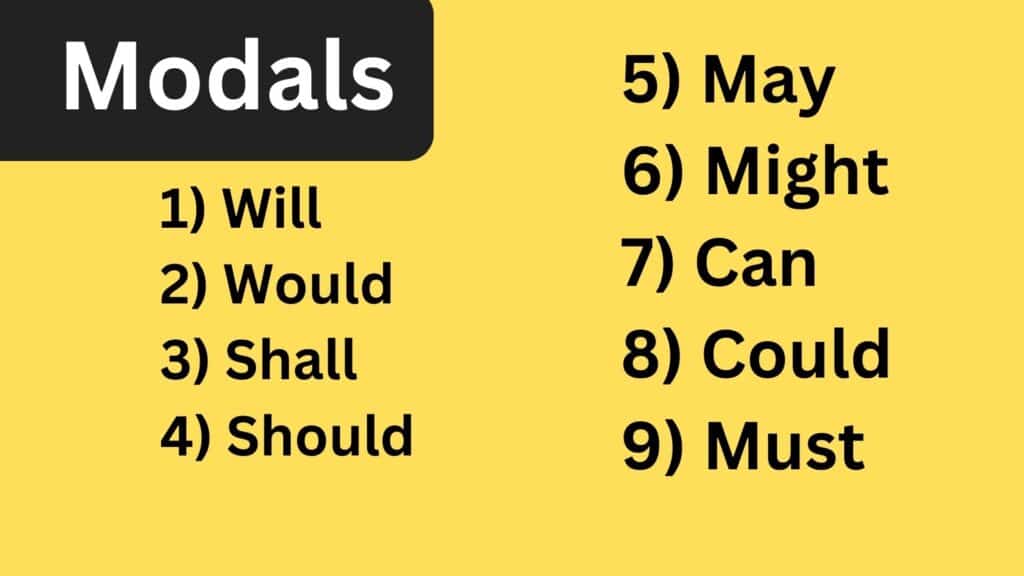
Positive Modals for Class 10th
1) Will
2) Would
3) Shall
4) Should
5) May
6) Might
7) Can
8) Could
9) Must
10) Have To
11) Need
12) Ought
13) Dare
14) Used To
Negative Modals for Class 10th
1) Will Not/ Won’t
2) Would Not/ Wouldn’t
3) Shall Not/ Shan’t
4) Should Not/ Shouldn’t
5) May Not/ Mayn’t
6) Might Not/ Mightn’t
7) Can Not/ Can’t
8) Could Not/ Couldn’t
9) Must Not/ Mustn’t
10) Don’t Have To
11) Need Not/ Needn’t
12) Ought Not To/ Oughtn’t To
13) Dare Not/ Daren’t
14) Used Not To/ Didn’t Use to
Modals for Class 10th Students: Important Exercise Questions
Complete the following exercises by using appropriate modal verbs. After finishing the exercises, verify your answers to ensure that you have used the correct verbs.
Exercise 1 – Fill in the Blanks
Fill in the blanks with accurate modals –
1. __________ you please pass me the salt?
a) Can
b) Should
c) Will
2. They said they __________ attend the meeting yesterday due to unforeseen circumstances.
a) can
b) must
c) couldn’t
3. __________ you like to join us for dinner tonight?
a) Will
b) Should
c) Would
4. She __________ have left her keys on the table.
a) may
b) must
c) might
5. __________ I use your phone for a quick call?
a) Must
b) Can
c) Should
6. We __________ study harder to improve our grades.
a) should
b) must
c) would
7. __________ you mind if I open the window?
a) Can
b) Would
c) Should
8. He __________ have completed the project by now.
a) must
b) might
c) should
9. __________ she come to the party if she’s feeling better?
a) Should
b) Might
c) Will
10. I think he __________ be at home by now.
a) can
b) should
c) would
Choose the correct modal verb for each question based on the context.
Answer of Exercise 1 – Fill in the Blanks
- Can you please pass me the salt?
- They said they couldn’t attend the meeting yesterday due to unforeseen circumstances.
- Would you like to join us for dinner tonight?
- She must have left her keys on the table.
- Can I use your phone for a quick call?
- We should study harder to improve our grades.
- Would you mind if I open the window?
- He must have completed the project by now.
- Will she come to the party if she’s feeling better?
- I think he should be at home by now.
Exercise 2 – Fill in the blanks
Here are the questions with three options each, where one of them is the correct modal verb. Fill in the blanks with correct modal verbs:
1. _______ you please help me carry this heavy box upstairs?
a) Will
b) Can
c) Should
2. I’m not sure if I can make it on time. _______ I take a cab to the airport?
a) Will
b) May
c) Shall
3. The weather looks unpredictable. _______ it rain later?
a) Would
b) Might
c) Should
4. _______ you like to come with us to the concert tomorrow?
a) Shall
b) Could
c) Would
5. Sarah said she _______ submit the report by the end of the day.
a) Must
b) Should
c) Will
6. _______ I have another piece of cake, or should I save some for others?
a) Can
b) Shall
c) May
7. The museum closes at 6 PM. _______ we hurry to see all the exhibits?
a) Must
b) Could
c) Should
8. We _______ cancel the picnic if it keeps raining.
a) Will
b) Should
c) Must
9. _______ I borrow your pen for a moment, please?
a) Can
b) May
c) Must
10. The kids have an early morning tomorrow. _______ they go to bed now?
a) Will
b) Should
c) Would
Answer of Exercise 2 – Fill in the Blanks
- Can you please help me carry this heavy box upstairs?
- I’m not sure if I can make it on time. May I take a cab to the airport?
- The weather looks unpredictable. Might it rain later?
- Would you like to come with us to the concert tomorrow?
- Sarah said she Will submit the report by the end of the day.
- Can I have another piece of cake, or should I save some for others?
- The museum closes at 6 PM. Should we hurry to see all the exhibits?
- We Should cancel the picnic if it keeps raining.
- Can I borrow your pen for a moment, please?
- The kids have an early morning tomorrow. Should they go to bed now?
Frequently Asked Questions on Modals for Class 10th
Q 1. What are modals used?
Modals are utilized to indicate our level of certainty regarding something, whether it is certain, possible, or impossible. For example: “My keys must be in the car.” and “It might rain tomorrow.”
Q 2. Why is it called a modal?
This category of element is referred to as “modal” because it introduces a secondary “mode” or user interface to the web page where it is present. When a modal window appears, it disables most of the page and prompts users to concentrate on a specific window before proceeding.
Q 3: How do you identify modals?
Modals frequently appear in sentences that predict future possibilities, describe abilities, give advice, make requests, or ask for permission. The nine most frequently used modals are can, could, shall, should, will, would, may, might, and must.
Q 4: Why is modal important?
Modal verbs, also known as modals, function as auxiliary verbs and convey modality. They play a significant role in expressing various intentions, providing a clearer message. These intentions encompass obligations, prohibitions, permissions, abilities, and suggestions, among others.
Q 5. How many modals are there?
There are nine primary modal verbs in English. These are:
1. can
2. could
3. may
4. might
5. will
6. would
7. shall
8. should
9. must
These modal verbs are used to express different meanings and functions, such as ability, permission, possibility, necessity, and more.
Median Formula Class 10th For Grouped and Ungrouped Data
Median Formula Class 10th: Statistics encompasses the gathering, examination, interpretation, and representation of extensive sets of numerical data. Captain John Graunt of London earned recognition as the pioneer of vital statistics due to his significant contributions in studying the statistics of births and deaths.
Among the key concepts in statistics, the median holds a vital position. Serving as a measure of central tendency, the median represents the middle-most value within a dataset. In this article, we will explore methods for calculating the median for both grouped and ungrouped data.
NCERT Math Median Formula Class 10th
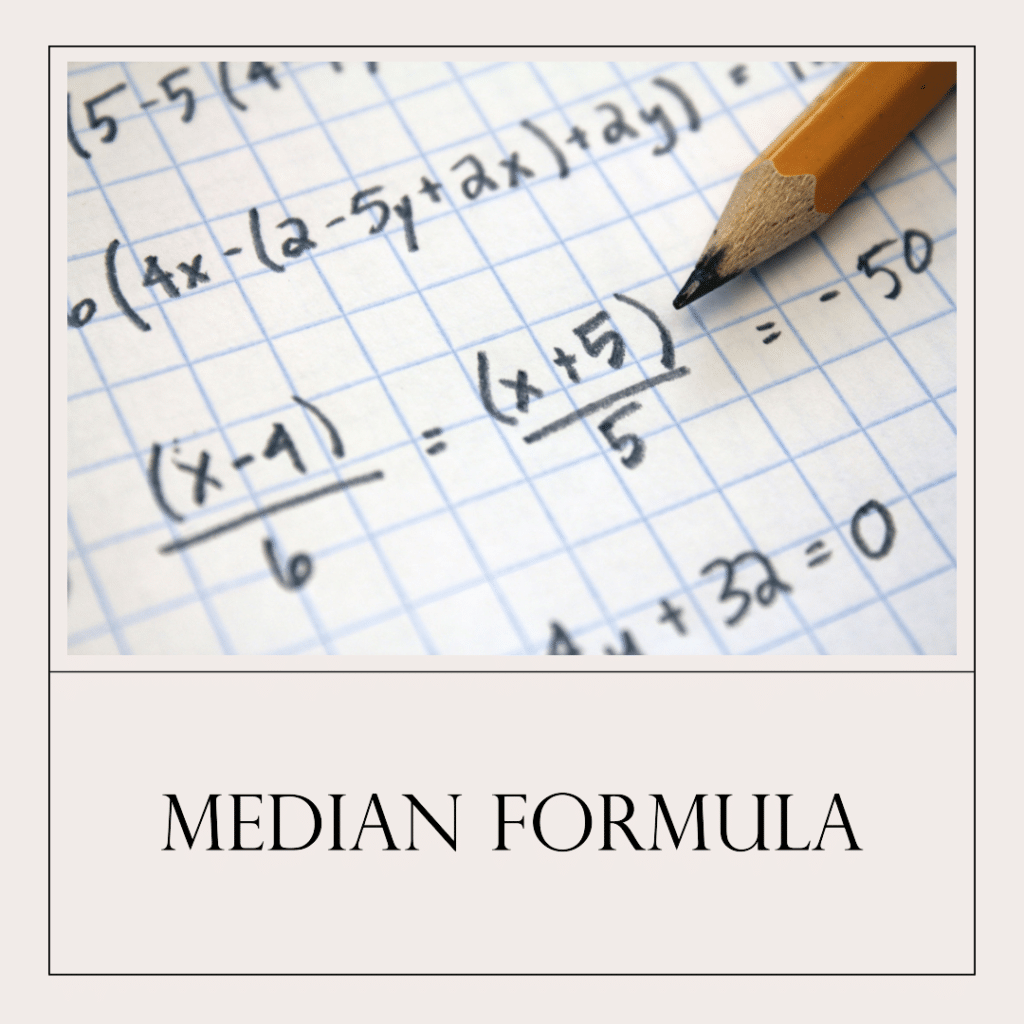
What is Median?
The median represents the middlemost value within a given set of data.
How to calculate Median Step by Step Process
Median Formula for ungrouped data:
1. Organize the provided values in ascending order.
2. Determine the total number of observations in the dataset, denoted as ‘n.’
3. If ‘n’ is an odd number, the median corresponds to the value of the [(n+1)/2]th observation.
4. If ‘n’ is an even number, calculate the median as the average of the (n/2)th and [(n/2)+1]th observations.
Median Formula for For grouped data:
- Step 1: Create a table with three columns – the first column is for the class interval, the second column for frequency (f), and the third column for cumulative frequency (cf).
- Step 2: Fill in the table by writing the class intervals and their corresponding frequencies.
- Step 3: Calculate the cumulative frequency by adding the frequency at each step in the third column (cf).
- Step 4: Find the sum of all frequencies (∑f); it should match the last number in the cumulative frequency column.
- Step 5: Calculate n/2 (where ‘n’ is the total number of observations). Identify the class whose cumulative frequency is greater than or closest to n/2; this class is known as the median class.
- Step 6: Now, apply the formula:
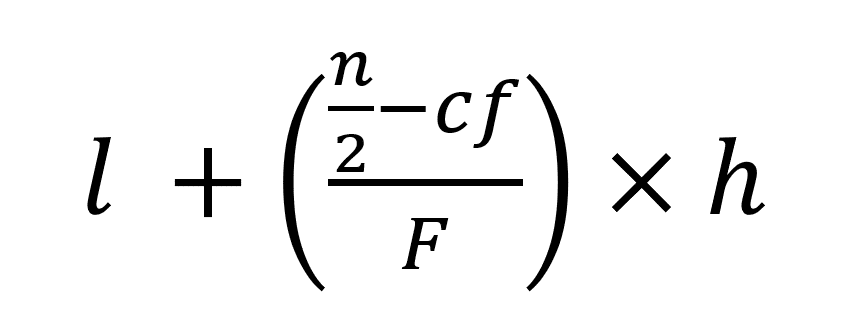
l = lower limit of the median class
n = number of observations
cf denotes the cumulative frequency of the class preceding the median class
f = frequency of the median class
h = class size (assuming classes are of equal size)
Median Formula Class 10th: Solved Example
Example 1: What is the median age of the students in a classroom with the following ages: 12, 14, 15, 16, 17, 18?
Solution:
To find the median age of the students in the classroom, follow these steps:
Step 1: Arrange the ages in ascending order:
12, 14, 15, 16, 17, 18
Step 2: Determine the total number of ages (n) in the dataset. In this case, n = 6.
Step 3: Since the number of ages (n) is even, we use the following formula to find the median:
Median = (n/2)th observation + [(n/2)+1]th observation / 2
Step 4: Substitute the values and calculate the median:
- Median = (6/2)th observation + [(6/2)+1]th observation / 2
- Median = 3rd observation + 4th observation / 2
- Median = (15 + 16) / 2
- Median = 31 / 2
- Median = 15.5
Therefore, the median age of the students in the classroom is 15.5 years.
Example 2: In a coding competition conducted at IIT, there were 50 participants. The median time taken by the participants to solve the coding problems was found to be 90 minutes. Now, you are given that 30 participants took more time than the median to solve the problems.
Can you calculate the maximum possible time (in minutes) taken by any participant to solve the problems in this coding competition?
Solution:
- Total number of participants (n) = 50
- Median time taken by participants = 90 minutes
- Number of participants taking more time than the median = 30
Since the median represents the middlemost value in the dataset, we can infer that there are 25 participants who took less time than the median (as there are 50 participants in total).
Now, we have the following information:
- Number of participants taking less time than the median = 25
- Number of participants taking more time than the median = 30
To find the maximum possible time taken by any participant, we can focus on the participants who took more time than the median. Since we don’t have the exact values of these 30 participants, we can only find the upper bound for the maximum time.
Since there are 30 participants who took more time than the median, the worst-case scenario for the maximum time taken by any participant would be if all these 30 participants took the exact same time, which is greater than the median.
Thus, the maximum possible time taken by any participant can be assumed to be the same as the median (90 minutes) or any value greater than 90 minutes.
In conclusion, the maximum possible time taken by any participant in the coding competition can be at least 90 minutes, but we cannot determine an exact value without more information about the individual times of those 30 participants.
Properties of Median in Statistics
The properties of the median in statistics can be summarized as follows:
- Independence: The median is not influenced by all the data values in a dataset. It is solely determined by its position within the sorted data.
- Positional Value: The median’s value is fixed by its position and does not directly represent any individual data point.
- Central Measure: The median’s distance to other values is smaller compared to any other point, making it a robust central measure.
- Uniqueness: Every dataset has a unique median, resulting in a single value that represents the middle observation.
- Non-Alterability: The median cannot be manipulated algebraically or combined through weighting; it retains its original position.
- Stability in Grouping: When data is grouped, the median remains stable and consistent.
- Limitation to Numeric Data: The median is not applicable to qualitative data and requires data to be grouped and ordered for calculation.
- Applicability to Scales: The median can be determined for datasets measured on ratio, interval, and ordinal scales.
- Robustness to Outliers: Outliers and skewed data have less impact on the median, making it a more resistant measure than the mean.
- Skewed Data Preference: In skewed distributions, the median is considered a better measure than the mean for representing the central tendency.
Read More
- Trigonometry Class 10 formulas List for NCERT Maths Students
- Sample Question Paper for Class 10 CBSE Maths With Solutions
- RD Sharma Class 10 Book Pdf Free Download Without Solutions
Frequently Asked Questions on Median Formula Class 10th
Q 1: How to find the median of ungrouped data?
To find the median of ungrouped data, follow these steps:
- Arrange the data in ascending order (from smallest to largest).
- Determine the total number of observations (n) in the dataset.
- If the number of observations (n) is odd, the median is the middlemost value. For example, if there are 9 data points, the 5th observation is the median.
- If the number of observations (n) is even, the median is the average of the two middlemost values. For example, if there are 10 data points, the 5th and 6th observations are the middlemost, and the median is the average of these two values.
Q 2: Which are the measures of central tendency?
The three main measures of central tendency are:
- Mean: The mean is the most commonly used measure of central tendency. It is calculated by summing up all the values in the dataset and then dividing by the total number of values (n).Mean = (Sum of all values) / n
- Median: The median is the middlemost value in an ordered dataset. It separates the higher half of the data from the lower half. To find the median, the data must be arranged in ascending or descending order, and if the number of observations (n) is odd, the median is the middle value; if n is even, it is the average of the two middle values.
- Mode: The mode is the value that appears most frequently in the dataset. It is possible for a dataset to have one mode (unimodal), two modes (bimodal), or more (multimodal), or it may have no mode if all values occur with the same frequency.
Q 3: What is the symbol of median?
The mean is commonly denoted by M, while the median is represented by Mdn. When referring to standard deviation, the symbol s (the Greek lower-case letter “sigma”) is typically used to represent the population standard deviation. On the other hand, s is employed to signify the standard deviation of a sample of scores.
Control and Coordination Notes Class 10: NCERT Science Ch. 6
Control and Coordination Notes Class 10: The intricately designed human body serves as a sophisticated mechanism, orchestrating a multitude of functions and processes crucial for sustaining life.
Within Class 10 Chapter 6 “Control and Coordination,” we delve into the fascinating exploration of how the body regulates its movements and harmonizes actions among different body parts and with the surrounding environment.
This study unveils the remarkable control systems at play that facilitate seamless coordination throughout the human organism.
NCERT Science Chapter 6 Control and Coordination Notes for Class 10
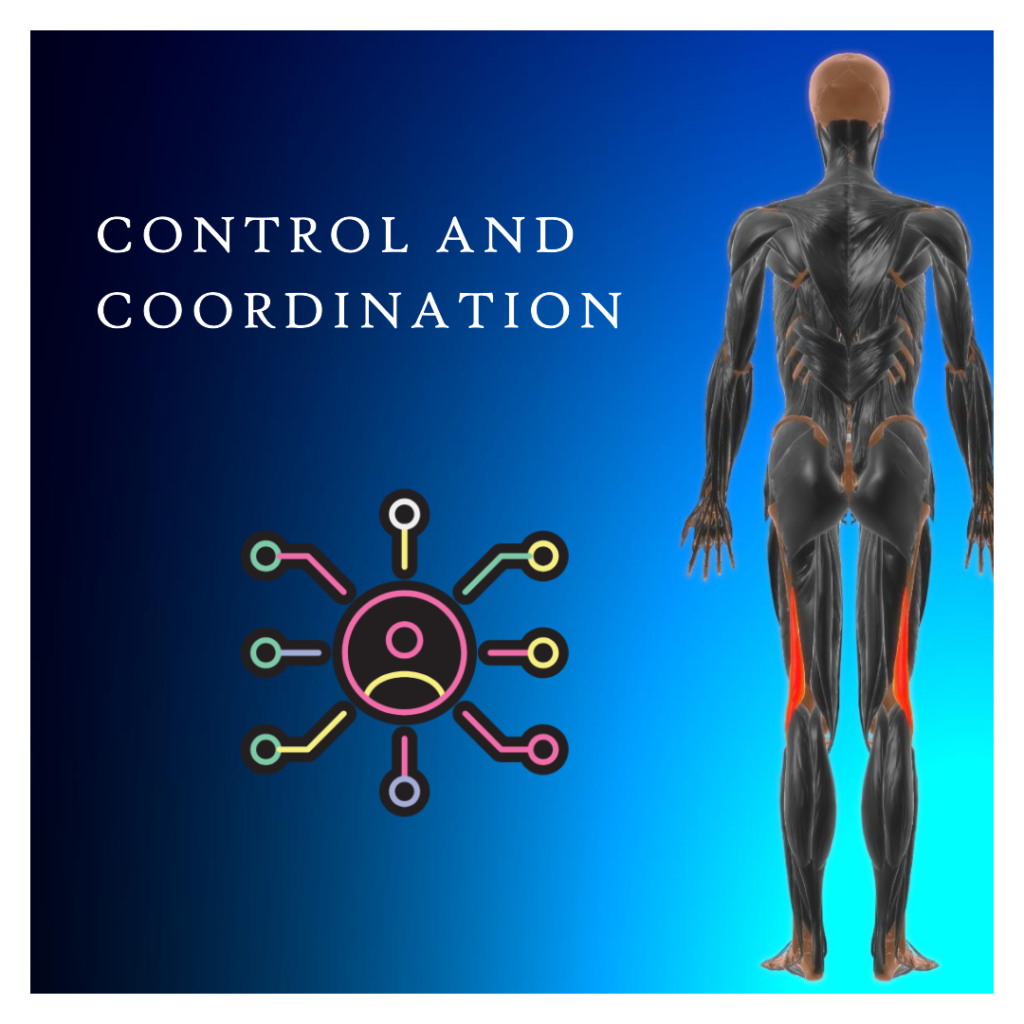
Control and Coordination Notes Class 10: The Nervous System
Movement in Organisms
Movement refers to the capability of organisms to manipulate specific body parts. When they relocate from one location to another, this process is known as locomotion. Furthermore, organisms demonstrate movements as a response to various stimuli.
Introduction to Control & Coordination
In response to diverse stimuli such as light, heat, nutrients/food, and more, organisms exhibit movement. The nervous and endocrine systems play a pivotal role in controlling and coordinating all activities in animals.
These two systems work hand in hand, with hormones serving as chemical messengers that aid the nervous system in executing various functions.
These hormones are secreted by endocrine glands. Additionally, in plants, hormones also serve as coordinators of movements, facilitating their responses to environmental cues.
The Nervous System

Types of Nervous System
Neuron
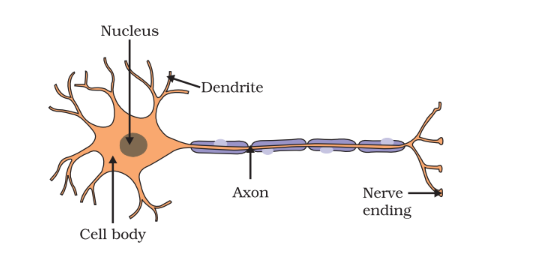
The neuron serves as the fundamental building block of the nervous system, encompassing both its structure and function.
Comprising three primary components, each neuron includes dendrites, cyton/soma/cell body, and an axon. Dendrites are responsible for receiving impulses from other neurons, while the cyton/soma processes these impulses. On the other hand, the axon is tasked with transmitting the impulse either to another neuron or to muscles, glands, and other target cells.
Neurons can exist in two forms: myelinated or non-myelinated. Myelinated neurons possess a myelin sheath, leading to faster impulse transmission compared to non-myelinated neurons. This intricate system of neurons facilitates swift and efficient communication within the nervous system.
Central Nervous System
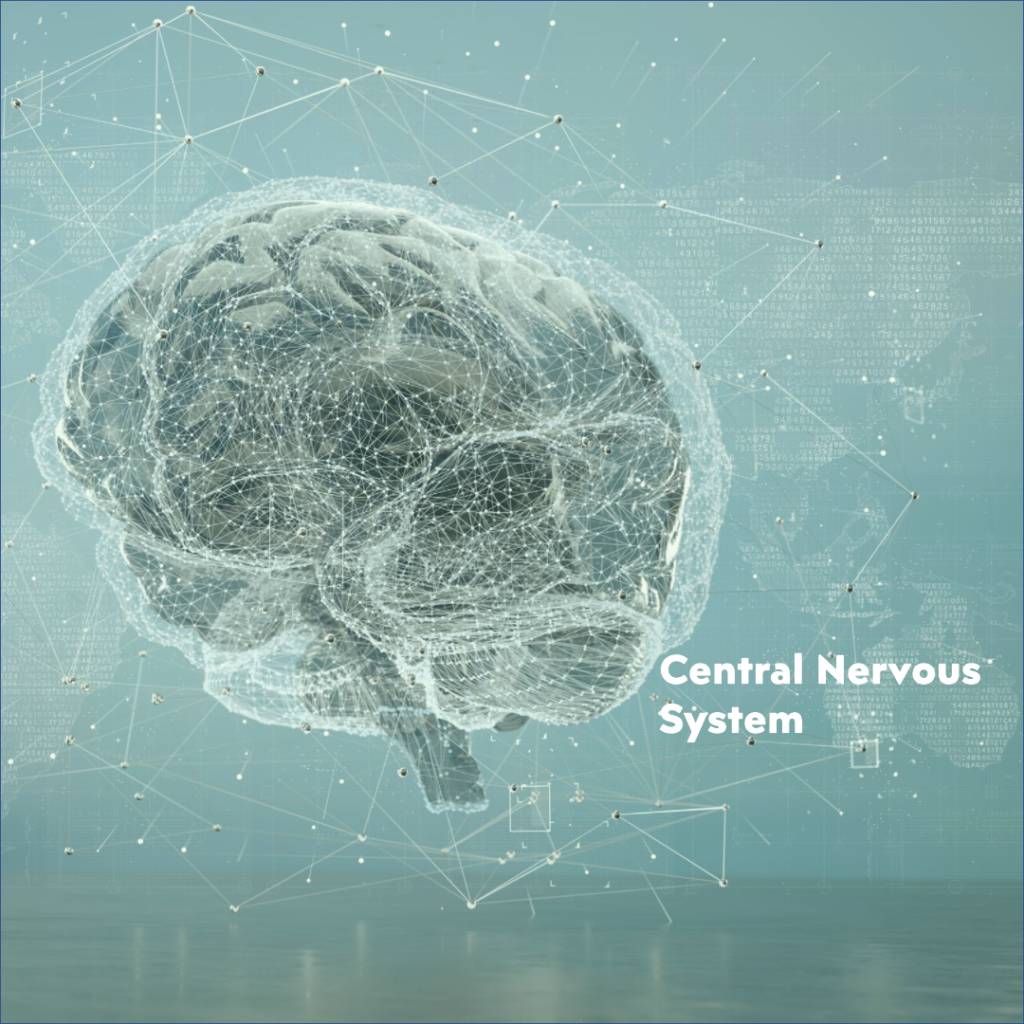
The central nervous system (CNS) comprises the brain and the spinal cord. The distinct parts of the brain fulfill various functions:
1. The cerebrum governs reasoning, logic, emotions, speech, memory, visual processing, recognition of auditory and taste stimuli, and more.
2. The cerebellum regulates and coordinates body movements, posture, and balance.
3. The pons serves as a relay station, transmitting signals from the hindbrain to the forebrain.
4. The Medulla Oblongata controls involuntary movements, including functions like vomiting, sneezing, yawning, heartbeat, breathing, blood pressure, etc.
5. The Medulla oblongata continues as the spinal cord, coursing through the vertebral column, and overseeing reflex actions.
Each part of the brain plays a vital role in maintaining bodily functions and supporting complex cognitive processes.
Peripheral Nervous System
The peripheral nervous system (PNS) is composed of nerves that emanate from both the brain and the spinal cord. In humans, this system comprises 12 cranial nerves and 31 spinal nerves.
These nerves extend throughout the body, facilitating communication between the central nervous system and various organs, muscles, and sensory receptors.
Somatic Nervous System
The somatic nervous system constitutes a component of the peripheral nervous system (PNS). It comprises the nerves responsible for controlling voluntary actions within the body.
Through the somatic nervous system, individuals can consciously and deliberately perform movements, enabling interactions with the external environment.
Autonomic Nervous System
The autonomic nervous system encompasses all the nerves within the peripheral nervous system (PNS) that oversee involuntary actions in the body. Vital functions such as respiration, heart rate, blood pressure, digestion, and more are regulated by the autonomic nervous system. It operates through two divisions known as the sympathetic and parasympathetic nervous systems.
The sympathetic nervous system readies the body for intense physical activity, often referred to as the fight-or-flight response. On the other hand, the parasympathetic nervous system exerts an opposite effect, promoting relaxation and inhibiting or slowing down many high-energy functions. These two divisions work in harmony to maintain a delicate balance in the body’s physiological responses to various situations and stimuli.
Reflex Action
A reflex is a spontaneous and involuntary reaction to stimuli, playing a crucial role in our renowned survival instinct.
Many common reflexes are a result of our well-trained and accumulated knowledge of caution that we have internalized over time.
They can manifest in various ways, such as quickly pulling back our hand when it touches an extremely hot or cold object—an action known as a reflex action. These reflexes are intricately linked to our instinctual responses, enabling swift and automatic protective measures to safeguard our well-being.
Reflex Arc
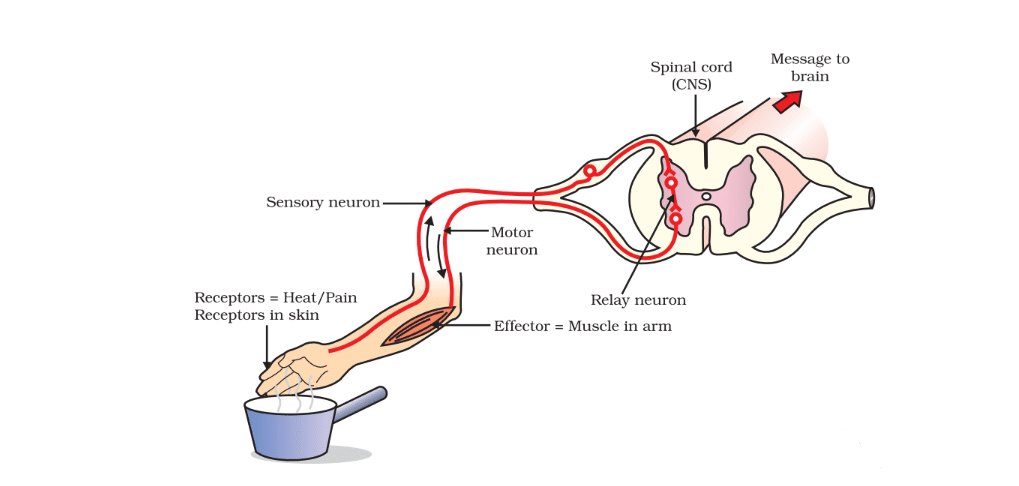
A reflex arc denotes the route taken by an electrical impulse during a reflex action.
The journey commences as the impulse travels from the receptor organ to either the spinal cord or the brain, where it undergoes processing. Once processed, the relevant information is relayed back to the appropriate muscle, prompting the action to be executed.
The components of a reflex arc encompass the receptor organ, the sensory/afferent neuron, the interneuron, the motor/efferent neuron, and the effector organ. These elements work in seamless coordination to ensure rapid and automatic responses to external stimuli, safeguarding the body from potential harm.
Protection of CNS
The brain is safeguarded by three primary layers of protection:
1. The bony skull, also known as the cranium, provides a sturdy and robust outer covering.
2. The cerebrospinal fluid acts as a cushioning and shock-absorbing layer that surrounds and supports the brain.
3. The meninges, comprising the Dura mater, Arachnoid, and Pia mater, form a protective membrane that encloses and shields the brain from potential harm.
Together, these layers form a formidable defense system, ensuring the brain’s well-being and functionality within the skull.
Plant Hormones and Movements
Plant Hormones
Hormones are responsible for orchestrating control and coordination in plants.
| Plant Hormone | Function |
|---|---|
| Auxin | It facilitates the growth of plant tissues. |
| Cytokinin | It stimulates cell division and retards cell aging. |
| Gibberellins | This hormone aids in stem growth, triggers seed germination, stimulates flowering, facilitates cell division, and supports seed development after germination. |
| Abscisic acid | It hinders growth, leading to leaf wilting, and encourages bud and seed dormancy. |
| Ethylene | This hormone is in gaseous form and induces the ripening of fruits. |
Growth Independent Movements
Movements that are unrelated to growth are referred to as nastic movements. These movements are triggered by environmental stimuli, but their direction of response is not determined by the direction of the stimulus.
The touch-me-not plant exhibits thigmonastic movement, which is a response to touch stimuli.
Growth-Related Movements in Plants
Movements that are related to growth are termed tropic movements. These movements arise in response to environmental stimuli, and the direction of their response is influenced by the direction of the stimulus.
Here are some examples of tropic movements:
1. Phototropic movement (light-dependent)
2. Geotropic movement (gravity-dependent)
3. Chemotropic movement (chemical-dependent)
4. Hydrotropic movement (water-dependent)
5. Thigmotropic movement (touch-dependent)
Geotropism
The response of plant parts to the Earth’s gravitational force is referred to as geotropism or gravitropism.
Positive geotropism is when plant parts grow towards gravity, while negative geotropism is when they grow away from gravity. For instance, roots exhibit positive geotropism as they grow towards the force of gravity, while shoots display negative geotropism by growing away from it.
Phototropism
Phototropism refers to the movement of plant parts in response to light.
Positive phototropism occurs when plant parts move towards light, while negative phototropism happens when they move away from light.
For example, stems exhibit positive phototropism as they bend towards the light source, while roots demonstrate negative phototropism by bending away from the light.
Hydrotropism
Hydrotropism refers to the movement of plant parts in response to water or moisture.
Positive hydrotropism occurs when plant parts move towards water, while negative hydrotropism happens when they move away from water.
For example, roots exhibit positive hydrotropism as they grow in search of water, such as moving towards areas with high humidity levels.
Chemotropism
Chemotropism refers to the movement of plant parts in response to chemical stimuli.
Positive chemotropism occurs when plant parts move towards the chemical source, while negative chemotropism happens when they move away from it. For example, the growth of the pollen tube towards the ovule is a demonstration of positive chemotropism, as it is attracted by chemical signals from the ovule.
Thigmotropism
Thigmotropism refers to the movement of plant parts in response to touch.
Positive thigmotropism occurs when plant parts move towards the touch stimulus, while negative thigmotropism happens when they move away from it.
For example, the movement of tendrils around a support is a demonstration of positive thigmotropism, as they respond to the touch of the support structure.
Importance of The Endocrine System for Control and Coordination Notes Class 10
Exocrine Glands
Exocrine glands are glands that release secretions through ducts, which open onto an epithelial surface.
Endocrine Glands
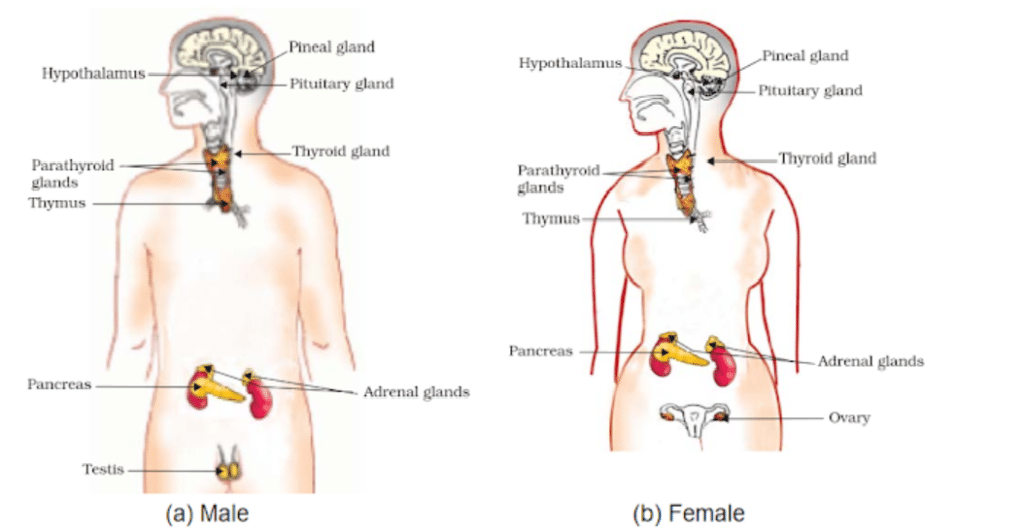
Endocrine glands in humans are ductless glands that release hormones directly into the bloodstream.
The human body houses various endocrine glands, including the pituitary, thyroid, adrenal, pineal, pancreas, ovary (female), testis (male), and more. Let’s delve deeper into the functions and roles of each of these glands below.
Pituitary Gland
Situated at the base of the brain, this gland is approximately the size of a pea.
Known as the master gland, it holds authority over the secretions of all other endocrine glands.
In addition, it releases the Growth Hormone (GH). If GH is under-secreted, it can lead to Dwarfism, while over-secretion results in Gigantism during childhood and Acromegaly in adulthood.
Thyroid Gland
Shaped like a butterfly, this gland resides in the throat region.
Its primary function involves releasing the hormone ‘Thyroxine,’ which plays a crucial role in regulating the body’s metabolism.
Iodine is an essential element required for synthesizing thyroxine within the body.
In situations of iodine deficiency, the gland under-secretes thyroxine, resulting in a condition known as goitre.
Pancreas
Located behind the stomach in the abdomen, this gland resembles a leaf in shape.
It functions as both an endocrine and exocrine gland.
As an endocrine gland, it produces two essential hormones – Insulin and glucagon. These hormones work in opposition to one another to regulate the blood sugar levels.
In its exocrine role, the gland secretes enzymes responsible for breaking down proteins, lipids, carbohydrates, and nucleic acids present in food.
Insufficient production of insulin by the pancreas can lead to diabetes, a condition characterized by abnormal blood sugar levels.
Adrenal Gland
Present in pairs above each kidney, these glands undergo a decrease in size as age advances.
They are responsible for secreting the hormone adrenaline, which plays a vital role in triggering the body’s flight or fight response during stressful situations.
Additionally, these glands also secrete noradrenaline, contributing to various physiological responses in the body.
Gonads
Gonads refer to the organs responsible for producing gametes – testes in males and ovaries in females.
In males, the testes produce the male hormone testosterone, while in females, the ovaries produce the female hormones estrogen and progesterone.
Testosterone and estrogen play crucial roles in gamete production and are responsible for the development of male and female sexual characteristics, respectively.
Progesterone is known as the pregnancy hormone, as it plays a vital role in supporting and maintaining pregnancy.
Other Endocrine Organs
In addition to the previously mentioned endocrine glands, the other endocrine organs encompass the hypothalamus, parathyroid, pineal, and thymus glands.
Read More
- Class 10 Notes for Science NCERT
- Chemical Reaction and Equation Notes Class 10 NCERT Sci. Ch.1
- Acids Bases and Salts Class 10 Notes of NCERT Science Ch. 2
- Life Process Notes Class 10 NCERT Science Chapter 5
- Class 10th How Do Organisms Reproduce Notes: Science Ch. 7
- Class 10th Heredity and Evolution Notes: NCERT Science Ch. 8
- Notes on Magnetic Effect of Electric Current Class 10 NCERT
- Human Eye and the Colourful World Notes Chapter 10 Science
- Metals and Non Metals Class 10 NCERT Science Chapter 3 Notes
- Class 10th Chapter 11 Science Notes for NCERT Students
- Notes of Our Environment Class 10: NCERT Science Chapter 13
Frequently Asked Questions on Control and Coordination Notes Class 10
What is the significance of the nervous system in control and coordination?
The nervous system plays a vital role in control and coordination as it enables the transmission of electrical impulses, facilitating communication among different body parts and the environment. It ensures swift responses to stimuli and aids in maintaining homeostasis, essential for the body’s proper functioning.
How do hormones contribute to control and coordination?
Hormones serve as chemical messengers in the endocrine system, responsible for control and coordination. They regulate various bodily functions, including growth, metabolism, and reproductive processes. By releasing hormones directly into the bloodstream, the endocrine system coordinates complex physiological responses throughout the body.
What are the key reflex actions in humans, and how do they work?
Reflex actions are involuntary responses to stimuli. Examples include the knee-jerk reflex and withdrawing a hand from a hot object. They occur through reflex arcs, involving sensory neurons, interneurons, and motor neurons. When a stimulus is detected, the impulse travels to the spinal cord or brain, which processes the information and sends a response back to the muscles, leading to the reflex action.
What are tropic movements in plants, and how do they work?
Tropic movements in plants are growth-related responses to environmental stimuli. Examples include phototropism (in response to light) and geotropism (in response to gravity). These movements are directed by the hormones auxin and gibberellin, which cause cells on the shaded side to elongate, leading to bending towards or away from the stimulus.
How does the endocrine system influence human growth and development?
The endocrine system significantly influences human growth and development. Hormones like growth hormone (GH), testosterone, and estrogen play pivotal roles in the growth of bones, muscles, and other tissues during puberty. Imbalances in these hormones can lead to growth disorders, affecting height and physical development. Additionally, thyroid hormones play a crucial role in metabolism, impacting energy levels and overall health throughout life.
Read Also:
- Chemical Reactions and Equations
- Acids, Bases and Salts
- Control and Coordination
- How Do Organisms Reproduce?
- Heredity and Evolution
- Magnetic Effects of Electric Current
- Our Environment
Class 10 Notes for Science NCERT
Providing a critical study resource for students, our chapter-wise NCERT Class 10 Notes for Science play a vital role in helping them excel in the CBSE Class 10 board exam. Effective studying and achieving good marks are essential for every student. To ensure their success, we offer comprehensive NCERT Class 10 Science Notes, complete with detailed explanations, illustrative examples, solved questions, and sample questions from NCERT books.
By meticulously referring to these notes during their studies, students can develop a proper study methodology. The notes are designed to give students a clear insight into all the important concepts and help them gain a strong grasp of the subject matter. The simplicity of the style and format used in these CBSE Notes makes it easier for students to retain and remember each concept effectively over an extended period.

NCERT Class 10 Notes for Science
Class 10 Science primarily covers crucial chapters from the NCERT book, such as chemical reactions and equations, electricity, magnetic effects of electric current, acids, bases and salts, control and coordination, reflection and refraction of light, carbon and its compounds, and more.
For your convenience, we have compiled CBSE Class 10 Science Notes on each of these topics in the table below. Simply click on the links to access the chapter-wise notes for the Class 10 Science subject.
- Chapter 1 – Chemical Reactions and Equations
- Chapter 2 – Acids, Bases and Salts
- Chapter 3 – Metals and Non-metals
- Chapter 4 – Carbon and Its Compounds
- Chapter 5 – Life Processes
- Chapter 6 – Control and Coordination
- Chapter 7 – How Do Organisms Reproduce?
- Chapter 8 – Heredity and Evolution
- Chapter 9 – Light Reflection and Refraction
- Chapter 10 – Human Eye and Colourful World
- Chapter 11 – Electricity
- Chapter 12 – Magnetic Effects of Electric Current
- Chapter 13 – Our Environment
Benefits of Studying of Class 10 Notes for Science
The Science notes provide students with a concise overview of all the concepts.
Studying through these notes proves invaluable during revision.
It optimizes students’ time during exam preparation.
By referring to these notes, students can easily recall all the crucial topics from each chapter.
These notes significantly enhance students’ understanding of the chapters. Furthermore, they serve as the ultimate revision resource before board exams.
Read More
- RD Sharma Class 10 Book Pdf Free Download Without Solutions
- NCERT Books for Class 10 Science – Download pdf
- Class 10 Science Book Pdf in Hindi Download for NCERT Students
Frequently Asked Questions on Class 10 Notes for Science
Which is the easy chapter in science class 10?
In CBSE 10th Board Physics, students have the opportunity to secure full marks in two straightforward and significant chapters: ‘Human Eye’ and ‘Magnetic Effects of Current’. Similarly, in CBSE 10 Chemistry, the easiest and highest-scoring chapters for students to excel in are ‘Chemical Equation & Reaction’ and ‘Acid, Base & Salt’.
Which is the hardest subject in class 10?
Undoubtedly, mastering mathematics and science can be challenging in board examinations. However, with diligent studying and preparation, these two subjects can become the foundation for your success in the CBSE 2022 Term 2 Class 10 board examinations.
How to study science class 10 easily?
1. Familiarize Yourself With the Syllabus and Exam Pattern.
2. Craft a Well-Structured Study Schedule.
3. Create Concise and Effective Short Notes.
4. Utilize the Best Reference Books Available.
5. Enhance Preparedness Through Mock Tests and Previous Year’s Question Papers.
6. Emphasize a Clear Understanding of the Concepts.
How to score 80 percent in Class 10?
1. Create Comprehensive Notes: Ensure you take clear and organized notes for each lesson taught in class.
2. Challenge Yourself: Engage in self-assessment and practice to test your knowledge.
3. Prioritize Restful Sleep: Get sufficient sleep to rejuvenate your mind for effective studying.
4. Practice Writing: Enhance your understanding by writing and practicing the concepts learned.
5. Time Management: Maintain control over your study time and create a productive routine.
6. Work with Past Test Questions: Solve previous year’s test questions to gain confidence and familiarity.
7. Emphasize Revision: Regular revision is crucial for reinforcing what you’ve learned.
Notes on Magnetic Effect of Electric Current Class 10 NCERT
Notes on Magnetic Effect of Electric Current Class 10: In Chapter 12 of the Class 10 science curriculum, the main focus lies on magnetic fields and electromagnetic effects. The chapter thoroughly explores the application of the magnetic effect of electric current in both electromagnets and electric motors.
Notes on Magnetic Effect of Electric Current Class 10
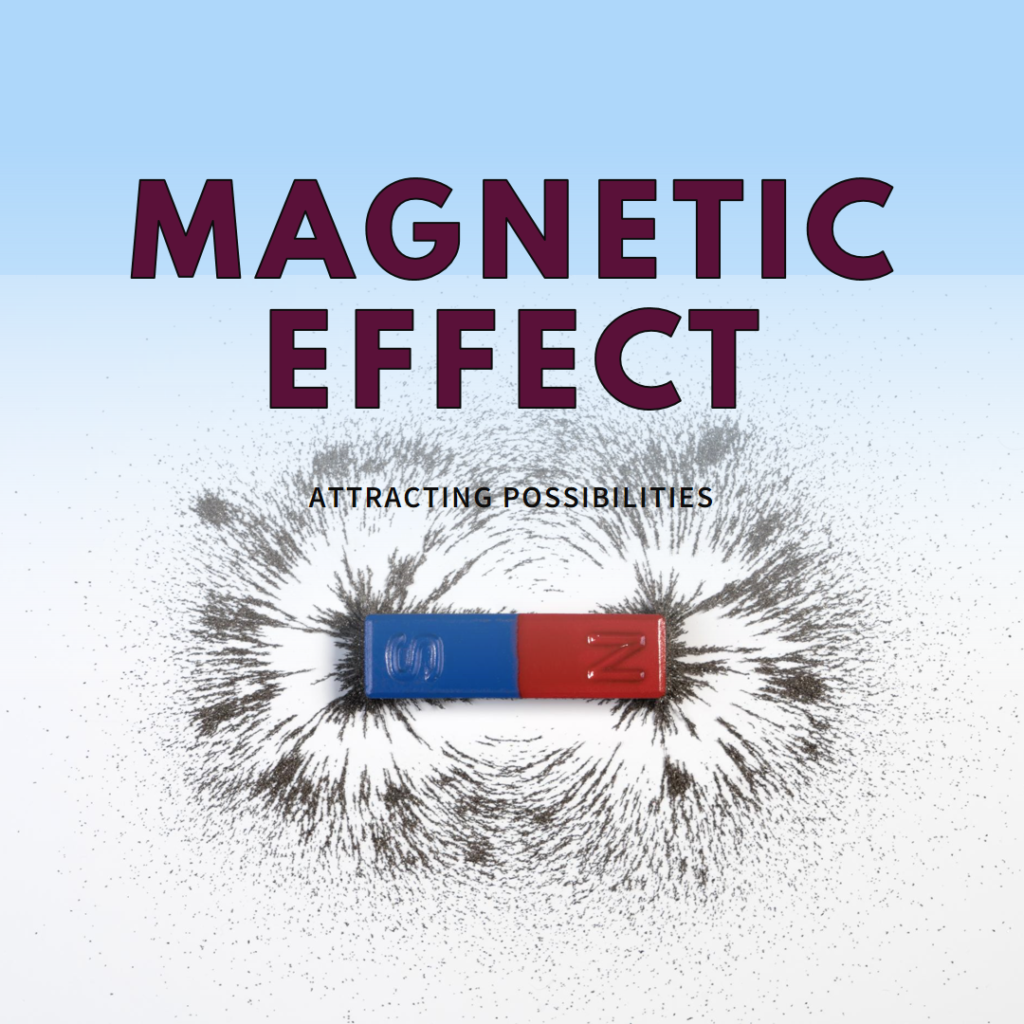
Notes on Magnetic Effect of Electric Current Class 10
Magnet
A magnet refers to a substance capable of generating a magnetic field that can either attract or repel other materials possessing magnetic properties. A natural example of this is lodestone, which possesses magnetic properties and attracts materials like Iron, Nickel, Cobalt, and others.
Every magnet is inherently bipolar, featuring distinct north and south poles that are inseparable. These two poles coexist and cannot be isolated. When a magnet is freely suspended, its north pole is the side that aligns with Earth’s geographic north.
Just like electric charges, magnetic poles also demonstrate attractive and repulsive behavior. Similar poles repel each other, while unlike poles are drawn together.
Bar magnet
A bar magnet is a rectangular object made of iron, steel, or any ferromagnetic material with inherent permanent magnetic characteristics. It possesses distinct north and south poles. When suspended freely, the bar magnet aligns its north pole towards Earth’s geographic north pole.
Magnetic Field
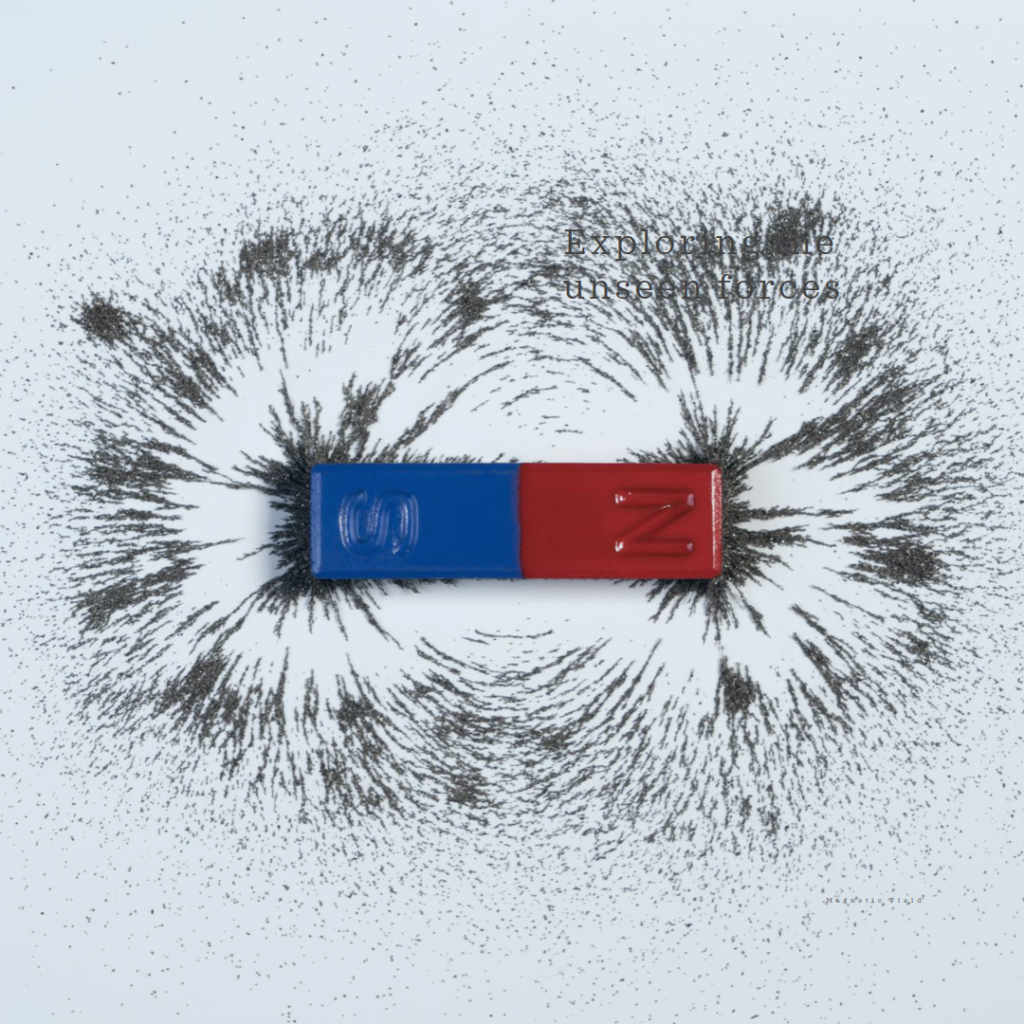
A magnetic field refers to the area surrounding a magnet where its magnetic influence can be observed. The direction and intensity of this magnetic field are depicted through lines of force known as magnetic lines.
Magnetic Field Lines
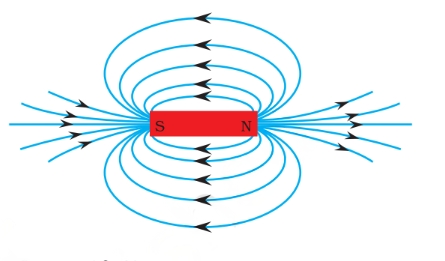
The magnetic field lines of a magnet form continuous and closed loops.
At any given point, the tangent to a field line indicates the direction of the total magnetic field.
The intensity and strength of the magnetic field increase with a greater number of field lines crossing per unit area.
The magnetic field lines do not intersect with each other.
Magnetic Field Lines for a Closed Loop
Due to the dipole nature of magnets, magnetic field lines must have a starting and ending point. As per convention, the field lines originate at the north pole and extend towards the south pole outside the bar magnet, while inside the magnet, they go from south to north.
This configuration results in the formation of closed loops. The strength of the magnetic field is greater where the field lines are closer or denser.
Iron Filings Test around a Bar Magnet
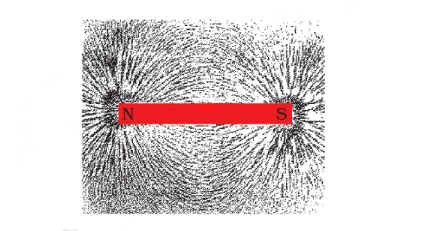
When iron filings are scattered around a bar magnet, they reveal the magnetic field lines that encircle the magnet. These magnetic field lines can be described as imaginary lines that visually depict the magnetic field encompassing any magnetic material.
Magnetic field lines do not intersect because it is not possible to have two different tangential magnetic field directions at the same point. If a compass needle were placed at such a point, it would indicate contradictory directions of the magnetic field, which is logically impossible.
Notes on Magnetic Effect of Electric Current Class 10
Oersted’s Experiment
Passing electric current through a conductor creates a magnetic field encircling it. This phenomenon becomes evident by observing the deflection of a magnetic needle near the conductor. The degree of deflection increases with a higher current flow. Reversing the direction of the current also leads to a reversal in the direction of the deflection shown by the magnetic needle.
Electromagnetism and Electromagnet
An electromagnet is a man-made magnet that generates a magnetic field when electric current flows through a conductor. This magnetic field vanishes when the current is switched off.
The process of creating or inducing a magnetic field through the flow of electric current is known as electromagnetism.
Magnetic Field Due to a Straight Current-Carrying Conductor
When electric current flows through a straight conductor, it generates a magnetic field surrounding it. This phenomenon becomes visible by using iron filings, which align themselves in concentric circles around the conductor.
Right-Hand Thumb Rule: Notes on Magnetic Effect of Electric Current Class 10
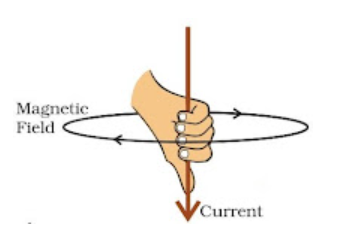
If you hold a straight conductor in your right hand with the thumb pointing in the direction of the current, the tips or curl of your fingers indicate the direction of the magnetic field encircling the conductor.
Magnetic Field Due to Current through a Circular Loop
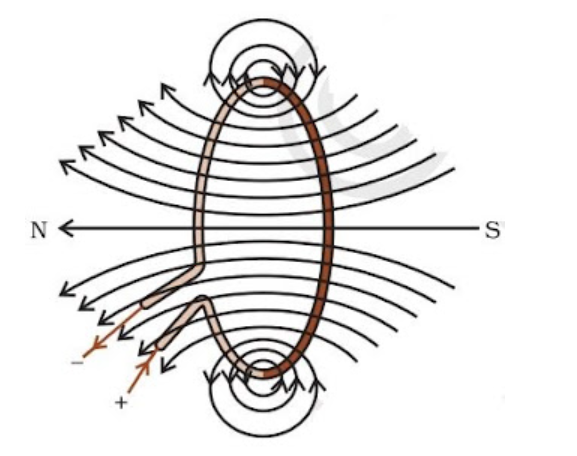
The right-hand thumb rule is applicable to a circular conducting wire as well, as it can be considered a collection of small straight segments. Each point along the wire carrying current generates a magnetic field that appears as straight lines at the center.
Magnetic Field Due to Current in a Solenoid
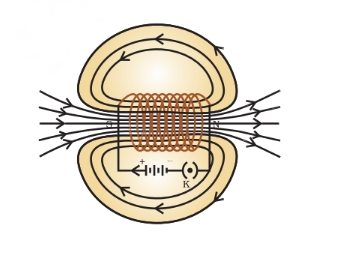
A solenoid is a cylindrical coil composed of numerous circular windings. When electric current passes through it, it exhibits magnetic properties akin to a bar magnet, producing a comparable field pattern. To enhance its magnetic strength, a soft iron core is often employed.
Notes on Magnetic Effect of Electric Current Class 10
Ampere’s Experiment
When an electric conductor is situated within a magnetic field, it encounters a force. The magnitude of this force is directly proportional to the current flowing through the conductor and is also perpendicular to both the length of the conductor and the magnetic field.
The force acting on a straight current-carrying conductor is mutually perpendicular to both the magnetic field and the direction of the current.
Fleming’s Left-Hand Rule
Fleming’s left-hand rule dictates that the direction of the force exerted on a current-carrying wire is perpendicular to both the direction of the current and the magnetic field.

Electric Motor
Through arm AB, current enters via brush X, and through brush Y, current flows from C to D. By applying Fleming’s Left-Hand Rule (LHR), we determine that the force pushes AB downwards and CD upwards.
In an electric motor, the split rings PQ function as a commutator, responsible for reversing the direction of the current periodically. This reversal occurs at each half-rotation, resulting in a continuous rotation of the coil.
Faraday’s Experiment: Notes on Magnetic Effect of Electric Current Class 10
Faraday made a significant discovery that a magnetic field can interact with an electric circuit and induce a voltage, which is referred to as EMF (electromotive force) through electromagnetic induction.
When a magnet is brought closer to a coil, it initiates a current in the coil circuit, which is evident by the deflection observed in the galvanometer needle.
Electromagnetic Induction
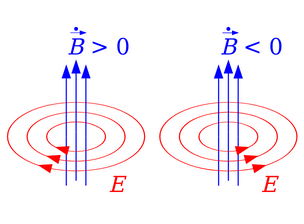
Electromagnetic induction is a phenomenon where an induced EMF and subsequent current are produced in a coil due to a changing magnetic field over time.
When a coil is positioned close to a current-carrying conductor, the magnetic field alters either due to a change in current (I) or due to the relative motion between the coil and conductor. The direction of the induced current is determined using Fleming’s right-hand rule.
Fleming’s Right-Hand Rule
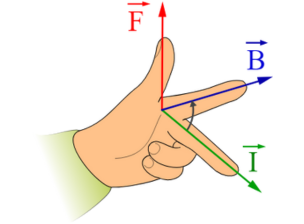
As per Fleming’s right-hand rule, you can use your right hand in the following manner: stretch your thumb, forefinger, and middle finger to be perpendicular to each other.
When the thumb represents the direction of the conductor’s movement, the forefinger points in the direction of the magnetic field, and the middle finger indicates the direction of the induced current.
Electric Generator
It transforms mechanical energy into electrical energy, functioning based on the principle of electromagnetic induction.
AC Generation: The setup comprises an axle connected to two rings, causing the arms AB and CD to move up and down within the generated magnetic field. Consequently, the induced current flows through the circuit ABCD.
After half a rotation, the current direction in both arms undergoes a change. By applying Fleming’s right-hand rule once more, the induced currents are established in these arms along the directions DC and BA. Therefore, the induced current flows through the circuit DCBA.
DC Generation: Similar to AC generation, the setup utilizes half rings to produce a current in one direction only, without any variations in magnitude.
Domestic Electric Circuits: Notes on Magnetic Effect of Electric Current Class 10
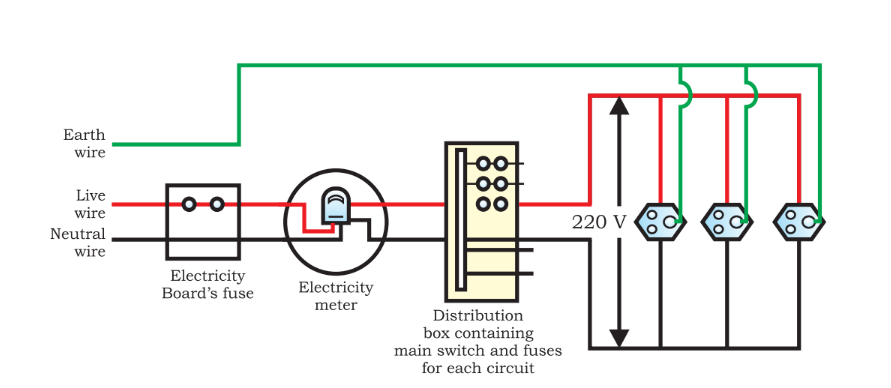
Fuse
A fuse serves as a protective device in electrical circuits during instances of overloading. Overloading occurs when the neutral and live wires come into contact due to insulation damage or a fault in the line.
During overloading, the current in the circuit increases, resulting in a short circuit that can be hazardous. The fuse device employs Joule’s heating (resistive or ohmic heating caused by the flow of current) to melt and break the circuit, thereby interrupting the current flow in the circuit.
Domestic Electric Circuits: Notes on Magnetic Effect of Electric Current Class 10
The live wire is coated with red insulation and carries a voltage of 220 V. The earth wire, covered with green insulation, maintains a voltage of 0 V, aligning with the Earth’s potential. The neutral wire, covered in black insulation, serves its purpose.
For domestic usage, our houses are supplied with alternating current (AC) electric power at 220 V with a frequency of 50 Hz.
Power Loss in Transmission
Power losses in transmission lines over long distances arise due to Joule’s heating. These losses are proportional to the square of the current (H ∝ I^2) and are caused by the line resistance (R).
Joule’s Law of Heating
Joule’s law provides a mathematical representation of how resistance in a circuit converts electric energy into heat energy. The first law of Joule describes the relationship between the heat produced by electric current flowing through a conductor, which can be expressed by the following formula:
Q = I^2 * R * T
Where Q represents the amount of heat generated, I is the electric current, R is the electric resistance in the circuit, and T denotes the time.
Read More
- Class 10 Notes for Science NCERT
- Metals and Non Metals Class 10 NCERT Science Chapter 3 Notes
- Chemical Reaction and Equation Notes Class 10 NCERT Sci. Ch.1
- Acids Bases and Salts Class 10 Notes of NCERT Science Ch. 2
- Life Process Notes Class 10 NCERT Science Chapter 5
- Control and Coordination Notes Class 10: NCERT Science Ch. 6
- Class 10th How Do Organisms Reproduce Notes: Science Ch. 7
- Class 10th Heredity and Evolution Notes: NCERT Science Ch. 8
- Class 10th Chapter 11 Science Notes for NCERT Students
- Notes of Our Environment Class 10: NCERT Science Chapter 13
Frequently Asked Questions on Notes on Magnetic Effect of Electric Current Class 10
Q 1. What is magnetic effect of electric current Class 10 concepts?
The magnetic effect of electric current is known as the electromagnetic effect. This implies that when a magnetic compass is brought close to an electrically charged conductor, the compass needle gets deflected due to the flow of electricity.
Q2. Who discovered the magnetic effect of electric current Class 10?
The discovery of the magnetic effect of current is credited to Hans Christian Oersted.
Q 3. What is the SI unit of magnetic flux?
The magnetic flux is measured in the SI unit called the Weber (Wb). When the flux density is one Weber per square meter (Wb/m^2), it is equivalent to one Tesla (T).
Q 4. What are two examples of magnetic effect of electricity?
Cranes utilize robust electromagnets for moving metallic objects. Electric bells employ electromagnets to generate sound. Additionally, induction motors harness the magnetic effect of current in their operation.
Q 5. How do magnetic effects relate to electromagnetic induction?
Electromagnetic induction is the process by which a changing magnetic field induces an electric current in a conductor. This phenomenon is the basis for many electrical devices and technologies, including generators and transformers.
Q 6. Can magnetic effects of electric currents be harmful?
While magnetic effects of electric currents are essential for many applications, strong magnetic fields can be harmful to certain electronic devices and even living organisms. It is crucial to exercise caution and use appropriate shielding when dealing with high-power magnets or magnetic fields.
Q 7. What is the significance of magnetic fields in transformers?
Transformers use magnetic fields to transfer electrical energy between two or more coils of wire. By inducing a magnetic field in one coil, it creates a varying magnetic flux that, in turn, induces a voltage in another coil, allowing for efficient electrical energy transfer.
Q 8. How do magnetic effects impact electric power transmission?
Magnetic effects play a crucial role in electric power transmission systems. They can cause power losses due to heat generation in transmission lines, requiring efficient designs to minimize energy wastage during long-distance electricity transmission.
Q 9. What is the application of magnetic effects of electric currents in class 10?
Magnetic effects of electric currents find applications in various devices and technologies, including electromagnets, electric motors, generators, transformers, and many other electrical appliances.
Q 10. How does an electric motor work?
An electric motor operates based on the principle of electromagnetic induction. When an electric current flows through a coil placed within a magnetic field, it experiences a force that causes the coil to rotate, leading to the movement of the motor’s shaft.
Our Environment Class 10 Chapter 13 Solution for NCERT
Our Environment Class 10: The NCERT Solutions for Class 10 Science Chapter 15, titled “Our Environment,” offer significant benefits to students in thoroughly grasping the concepts. These solutions are meticulously crafted by subject experts in accordance with the latest CBSE syllabus.
The comprehensive questions and detailed answers provided in the NCERT Solutions enable students to comprehend the core ideas and principles covered in the CBSE Class 10 Science examination. By studying from these solutions, students can enhance their chances of achieving good marks in their exams.
This chapter delves into various aspects of the environment, such as the composition of air, the significance of air in soil, the role of oxygen in supporting living organisms, and the importance of the atmosphere for both plants and our survival. By exploring these topics, students can gain valuable knowledge about their surroundings and their impact on life.
In conclusion, utilizing the NCERT Solutions for Class 10 Science Chapter 15 equips students with a deeper understanding of the subject matter, enabling them to excel in their academic endeavors.
Our Environment Class 10 Chapter 13 Solution for NCERT

Our Environment Class 10 Chapter 13 Solution for NCERT
Q 1. What are the trophic levels? Give an example of a food chain and state the different trophic levels in it.
The food chain operates through the transfer of food or energy at different levels, which are referred to as trophic levels.
For instance:
Grass → Goat → Man
In this food chain:
– Grass occupies the first trophic level.
– The goat occupies the second trophic level.
– Man occupies the third trophic level.
At each trophic level, energy is passed from one organism to another, demonstrating the flow of nutrients and energy through the ecosystem.
Q 2. What is the role of decomposers in the ecosystem?
Decomposers play crucial roles within the ecosystem:
1. Acting as environmental cleansers, they decompose deceased plants and animals, aiding in the breakdown and removal of organic matter.
2. They contribute to nutrient recycling, breaking down organic material and releasing essential nutrients back into the ecosystem for reuse.
3. By decomposing the deceased, they create room for new life forms to thrive in the biosphere, ensuring the continuous cycle of life.
4. Decomposers play a vital role in returning various elements to the water, soil, and air, making them available again for producers like crop plants to utilize. This process sustains the ecosystem’s balance and productivity.
Q 3. Why are some substances biodegradable and some non-biodegradable?
The distinction between biodegradable and non-biodegradable substances stems from the specific roles of microorganisms, such as bacteria, and decomposers, like saprophytes. These natural agents are equipped to break down certain materials in the environment, like paper and wood, which are considered biodegradable. However, human-made products like plastics cannot be broken down by these organisms. As a result, some substances fall into the category of biodegradable, while others are classified as non-biodegradable.
Q 4. Give any two ways in which biodegradable substances would affect the environment.
Biodegradable substances have several positive impacts on the environment:
1. Environmental cleanliness is maintained, as biodegradable materials readily undergo decomposition.
2. Biodegradable substances efficiently participate in the geochemical cycle with the assistance of decomposers, ensuring a smooth and natural recycling process.
Q 5. Give any two ways in which non-biodegradable substances would affect the environment.
Non-biodegradable substances can have adverse effects on the environment:
1. They contribute to pollution of the air, soil, and water, posing a significant threat to ecosystems and living organisms.
2. Non-biodegradable substances may lead to bio-magnification within the food chain, potentially impacting humans at the top of the chain, posing serious risks to their health and well-being.
Q 6. What is ozone, and how does it affect the ecosystem?
Ozone is a unique molecule consisting of three oxygen atoms, and it is considered an isotope of oxygen. The ozone layer’s primary role is to shield the Earth’s surface from the detrimental effects of the sun’s harmful UV rays. These rays pose a significant risk to living organisms and have the potential to cause skin cancer. Thus, the ozone layer acts as a crucial protective barrier safeguarding life on our planet from the harmful impacts of excessive ultraviolet radiation.
Q 7. How can you help in reducing the problem of waste disposal? Give any two methods.
To address the issue of waste disposal effectively, consider the following approaches:
1. Embrace the 3 Rs: To minimize waste disposal problems, adopt the principles of the 3 Rs: reduce, recycle, and reuse. Reduce your consumption and waste generation, recycle materials whenever possible, and find ways to reuse items to extend their lifespan. Additionally, opting for public transport over private vehicles not only reduces waste but also helps in lowering air pollution.
2. Composting: Dispose of biodegradable waste, such as kitchen scraps, through composting. By composting organic materials, you can divert them from landfills and create nutrient-rich compost, benefiting soil health and reducing overall waste.
By implementing these waste reduction strategies, we can make a significant positive impact on waste management and promote a cleaner and more sustainable environment.
Q 8. Which of the following groups contain only biodegradable items?
a. Grass, flowers and leather
b. Grass, wood and plastic
c. Fruit peels, cake and lime juice
d. Cake, wood and grass
a) Grass, flowers, and leather
c) Fruit peels, cake, and lime juice
d) Cake, wood, and grass
The groups listed above consist exclusively of biodegradable items. However, since plastic is not biodegradable, any group that includes plastic cannot be considered biodegradable.
Q 9. Which of the following constitutes a food chain?
a. Grass, wheat and mango
b. Grass, goat and human
c. Goat, cow and elephant
d. Grass, fish and goat
In the group comprising of grass, goat, and human:
The grass functions as the producer, as it generates its own food through photosynthesis.
The goat takes on the role of the primary consumer, as it directly consumes the grass for sustenance.
The human serves as the secondary consumer, as they consume the goat, which in turn relies on the grass for its nourishment.
Q 10. What will happen if we kill all the organisms at one trophic level?
Eliminating all the organisms within a specific trophic level will disrupt the flow of food to the next level, leading to an ecological imbalance. Consequently, the higher-level animals will suffer, potentially causing a surge in the population of lower trophic level animals. This uncontrolled growth can severely impact the overall equilibrium within the ecosystem. Maintaining the delicate balance between trophic levels is crucial for the stability and sustainability of the entire ecosystem.
Q 11.Will the impact of removing all the organisms in the trophic level be different for different trophic levels? Can the organisms of any trophic level be removed without causing any damage to the ecosystem?
Indeed, the consequences of eliminating all organisms within a trophic level will vary across different trophic levels. For instance, if all the producers are removed, it could lead to the death or migration of primary consumers, thereby disrupting the balance of trophic levels. This principle applies uniformly to all trophic levels.
Hence, the removal of organisms at any level would result in an upset of the entire ecosystem, as the disruption of the food chain would reverberate throughout. The survival of higher-level animals is entirely reliant on the presence and stability of animals at the lower levels within the ecosystem.
Q 12. What is biological magnification? Will the levels of this magnification be different at different levels of the ecosystem?
Biological magnification refers to the gradual rise in the concentration of non-biodegradable pollutants within the food chain.
With each successive trophic level in the ecosystem, the magnification intensifies, impacting all the other levels and leading to varying concentrations compared to the initial level. This phenomenon highlights the potential risks and consequences of accumulating harmful substances as they move up the food chain, posing a threat to organisms at higher levels.
Q 13. What are the problems caused by the non-biodegradable wastes that we generate?
Non-biodegradable wastes give rise to several issues:
1. Microorganisms cannot decompose these substances, leading to their persistence in the environment.
2. As the quantity of non-biodegradable wastes increases, disposal becomes a challenging problem.
3. Hazardous non-biodegradable wastes, such as heavy metals, may enter the food chain, affecting organisms at higher trophic levels.
4. These wastes have the potential to contaminate groundwater, resulting in soil infertility and disruption in soil pH levels.
Q 14. If all the waste we generate is biodegradable, will this have no impact on the environment?
Biodegradable wastes undergo decomposition by microorganisms, producing simpler substances that can be utilized as raw materials by producers. However, excessive biodegradable waste can lead to the following effects:
1. Slow decomposition of biodegradable wastes results in the emission of unpleasant odors, posing potential harm to humans when inhaled.
2. Dumping areas of excessive biodegradable wastes can become breeding grounds for harmful organisms, posing risks to humans, plants, and animals alike.
3. A surge in the population of aquatic organisms due to biodegradable waste can lead to oxygen depletion in water bodies, potentially harming aquatic ecosystems.
Q 15. Why is damage to the ozone layer a cause for concern? What steps are being taken to limit this damage?
The ozone layer serves as a protective shield for the Earth, safeguarding it from harmful UV rays that can lead to skin cancer. However, the ozone layer’s depletion is primarily caused by air pollutants like chlorofluorocarbons (CFCs). Excessive UV rays can have detrimental effects on plants, affecting photosynthesis, and harming vital organisms such as plankton and decomposers. This concern arises from the potential consequences of ozone layer damage.
To address this issue, both developing and developed countries have taken measures to combat the problem. Many nations have signed agreements with and are adhering to the guidelines set forth by the United Nations Environment Programme (UNEP). These guidelines aim to freeze or limit the production and usage of CFCs, serving as a crucial step to mitigate the depletion of the ozone layer.
Key Features of NCERT Solutions for Science Chapter 13 – Our Environment Class 10
Comprehensive answers to the chapter questions have been compiled below using lucid language that can be understood by all.
These answers are genuine and appropriate, making them suitable for CBSE exams, Olympiads, and other competitive exams. The provided responses are concise to aid students in better understanding the concepts.
Please feel free to refer to these solutions to enhance your preparation for various examinations. If you have any further queries, do not hesitate to ask for more detailed explanations. Happy learning!
Read More
- NCERT Solutions Science Class 10 All Chapter
- Chemical Equations and Reactions Class 10: Solution of Sci. Ch.1
Frequently Asked Questions on Our Environment Class 10 NCERT Solutions for Science Chapter 13
Q 1. What is the importance of our environment Chapter for class 10 student?
The environment chapter holds significant importance for Class 10 students as it offers essential insights into the delicate balance of nature and its impact on our lives.
Understanding the environment helps students comprehend the interdependence between living organisms and their surroundings, fostering ecological awareness and responsible behavior.
Knowledge about air, water, soil, and ecosystem components empowers them to become environmentally conscious citizens, contributing to sustainable practices and conservation efforts. Moreover, learning about biodegradable and non-biodegradable substances, pollution, and waste management equips students with practical solutions to address pressing environmental challenges.
This knowledge enables them to make informed decisions, promoting a healthier and harmonious coexistence with the natural world.
Q 2. What is the summary of our environment?
The environment can be divided into three main components:
1. Natural components, which include air, water, land, and all living organisms present in the ecosystem.
2. Human components, encompassing individuals, families, and communities that interact and influence the environment.
3. Human-made components, which consist of artificial structures such as roads, monuments, and industries.
Our environment is a dynamic blend of both natural and human-made elements, creating a complex interplay of phenomena that shape the world around us.
Q 3. What are the things that make our environment?
The environment comprises both a physical and a biological component. The physical part includes non-living elements and conditions such as mountains, valleys, rivers, streams, rocks, soils, sunlight, heat, rain, and snow.
On the other hand, the biological part encompasses living organisms like plants, animals, fungi, and bacteria. Together, these components interact to shape the ecosystem, influencing the life and activities of all living beings in the environment.
Q 4. How can we protect the environment?
Adopt sustainable practices to protect our environment:
1. Reduce, reuse, and recycle to conserve resources and reduce landfill waste.
2. Volunteer for community cleanups and watershed protection to contribute to a cleaner environment.
3. Educate yourself and others about the value of natural resources.
4. Conserve water to minimize ocean pollution from runoff and wastewater.
5. Make sustainable seafood choices to support responsible fishing practices.
6. Opt for eco-friendly shopping by reducing plastic use and using reusable bags.
7. Use energy-efficient light bulbs to reduce greenhouse gas emissions, and remember to turn off lights when not in use.
8. Plant trees to promote oxygen, energy savings, and combat climate change.
9. Use non-toxic chemicals at home and work to avoid contaminating waterways.
10. Opt for biking over driving to reduce emissions and promote a greener environment.
Notes of Our Environment Class 10: NCERT Science Chapter 13
Notes of Our Environment Class 10: The environment encompasses the habitat in which an organism flourishes, encompassing living and non-living elements such as physical, chemical, and biotic factors. In this chapter, we delve into the diverse components of the environment, explore their intricate interconnections, and gain insights into how human activities impact this delicate ecosystem.
Notes of Our Environment Class 10: NCERT Science Chapter 13

Notes of Our Environment Class 10: NCERT Science Chapter 13
Ecosystem
An ecosystem encompasses the dynamic interplay of both biotic and abiotic factors within a specific area. Biotic elements encompass all living organisms like plants, animals, microorganisms, and humans. On the other hand, abiotic components include sunlight, temperature, air, wind, rainfall, soil, minerals, and more. Examples of ecosystems include pond ecosystems, grassland ecosystems, and various others where these components interact harmoniously.
Mode of Nutrition in Animals and Plants
Living organisms exhibit two primary modes of nutrition: Autotrophic and Heterotrophic. Autotrophic organisms, such as plants and certain bacteria, can produce their own food through photosynthesis. On the other hand, Heterotrophic organisms, including animals, fungi, and some bacteria, rely on consuming other organisms for their nutritional needs.
Saprophytes and Decomposers
These factors play vital roles in the ecosystem’s nutrient cycling. Saprophytes, like fungi and microorganisms, feed on dead and decaying materials, absorbing nutrients from decomposing plant and animal matter. Decomposers, such as bacteria, worms, slugs, and snails, break down organic matter and waste, releasing nutrients back into the soil. Their work is crucial for soil biology as they transform complex organic substances into simpler compounds that plants can utilize for various metabolic activities.
Biotic Components
The living entities within the environment encompass a diverse range of organisms, including plants, animals, microbes, and fungi.
Abiotic Components
The Abiotic Components of the environment comprise non-living chemical and physical elements, including soil, air, water, temperature, and others. These abiotic factors play a significant role in shaping the ecosystem and influencing the distribution and behavior of living organisms within it.
Trophic Levels
The term “trophic levels” pertains to the different stages in a food web, delineated by the flow of energy. These trophic levels are as follows:
1. Producers (T1): Organisms capable of synthesizing their own food, usually through photosynthesis, forming the foundation of the food chain.
2. Primary consumers (herbivores – T2): The organisms that directly feed on the producers, consuming plant material as their source of energy.
3. Secondary consumers (primary carnivores – T2): These are the carnivores that feed on the primary consumers, acquiring energy by consuming herbivorous animals.
4. Tertiary consumers (secondary carnivores – T3): Carnivores that occupy the third trophic level, preying on other carnivores to obtain their energy.
5. Quaternary consumers (tertiary carnivores – T4): Carnivores situated at the fourth trophic level, consuming other tertiary carnivores.
6. Decomposers: Organisms that break down organic matter and detritus, returning nutrients to the environment, and playing a crucial role in nutrient recycling.
Pyramid of Trophic Levels of Our Environment in Class 10
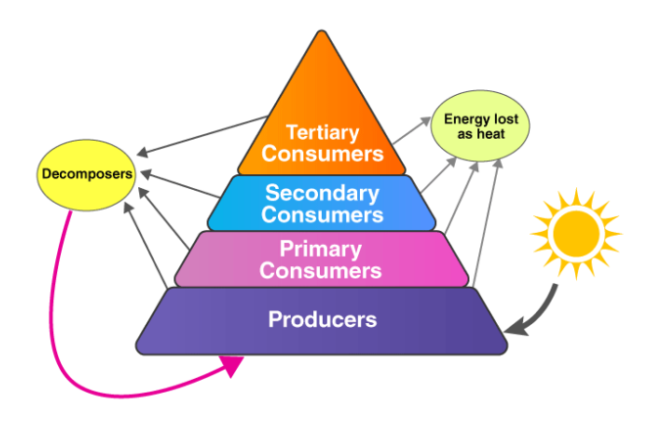
A graphical representation in ecology portrays the organization of trophic levels and can take the form of three types:
1. Pyramid of numbers: This depicts the number of organisms present at each trophic level, starting with producers. It can appear either upright or inverted, depending on the population distribution across trophic levels.
2. Pyramid of biomass: Here, the biomass of each trophic level is illustrated, with producers at the base. Similar to the pyramid of numbers, it can be either upright or inverted, reflecting variations in biomass distribution.
3. Pyramid of energy: This representation is always upright as it showcases the flow of energy from one trophic level to the next. Producers form the foundation, and the energy decreases as it moves up the pyramid to higher trophic levels.
Each type of pyramid provides valuable insights into the ecosystem’s structure and energy dynamics, contributing to a comprehensive understanding of its functioning.
Law of Conservation of Energy
The principle of energy conservation states that energy cannot be created nor destroyed; instead, it undergoes transformation from one form to another.
In biological systems, this energy flows from one organism to another, transferring across trophic levels in the food chain.
Energy Flow
The transfer of energy from one trophic level to another is depicted by the pyramid of energy, illustrating both its direction and amount.
In any given food chain, only approximately 10% of the energy is passed on from one trophic level to the next.
Food Chain
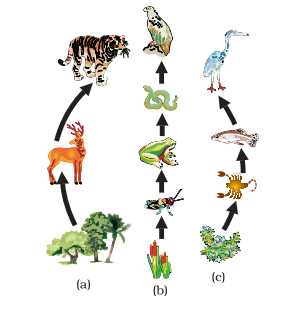
A food chain is the sequence of events within an ecosystem where one living organism consumes another, and subsequently, that organism becomes prey to a larger organism. This process of nutrient and energy transfer from one organism to another at various trophic levels creates the food chain.
Furthermore, the food chain illuminates the feeding patterns and relationships among living organisms. Trophic levels represent the distinct stages in a food chain, beginning with producers at the base, followed by primary, secondary, and tertiary consumers. Each level in the food chain is referred to as a trophic level.
Food Web
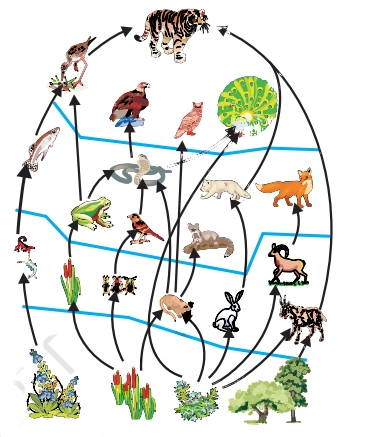
A food web is a complex network formed by several interconnected food chains. While it shares similarities with a food chain, a food web is notably larger in scope. In a food web, some organisms are either consumed by multiple predators or consume several other organisms themselves, leading to a multitude of interconnections between trophic levels.
This interconnectedness is where the food chain falls short in accurately showcasing the flow of energy. In contrast, the food web excels in representing the proper flow of energy by illustrating the intricate interactions between various organisms within the ecosystem. The food web provides a more comprehensive and realistic portrayal of the complex relationships and energy transfers that occur within a given ecosystem.
What is Environment? – Notes for Class 10 Students
The environment encompasses everything surrounding us, comprising both living and non-living elements, such as soil, water, animals, and plants, all of which adapt harmoniously to their surroundings. It is a precious gift from nature that sustains life on Earth.
The environment plays a pivotal role in supporting life on our planet. The term “Environment” originates from the French word “Environ,” signifying “surrounding.” An ecosystem encompasses all living and non-living entities within the environment, forming the foundational basis of the Biosphere, which profoundly influences the overall health of Earth.
Within the realm of life sciences, Ecology and Environmental science are significant branches that primarily focus on studying organisms, their interactions with one another, and their surroundings. These disciplines provide invaluable insights into the complex dynamics of life and its interconnectedness with the environment.
Ecosystem
An ecosystem constitutes a fundamental building block of ecology, encompassing both the structural and functional aspects of living organisms and their interactions with the surrounding environment. Simply put, it represents a chain of intricate relationships between organisms and their ecological surroundings. The term “Ecosystem” was initially coined by A.G. Tansley, an English botanist, in 1935.
Continue reading to delve into comprehensive notes that explore the ecosystem’s structure, components, various types, and the essential functions it fulfills within the natural world.
Pollution
Numerous types of pollution predominantly arise due to human activities, known as anthropogenic causes. Additionally, globalisation has played a part in pollution by driving humanity’s persistent demand for natural resources, leading to significant changes in the Earth’s landscape.
While advancements have improved the quality of life, they have also brought about new challenges that increasingly affect human health and the environment. This article aims to delve into the concept of pollution, its underlying causes, and the various types it manifests. Furthermore, we will examine the far-reaching impacts of pollution on both human health and the environment.
Types of Pollution
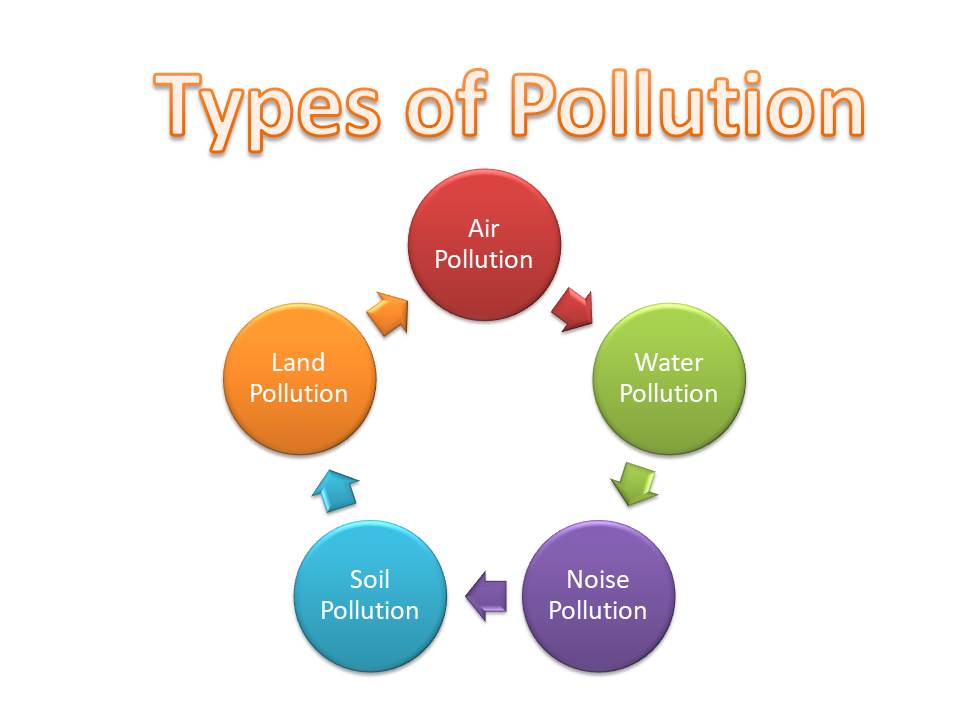
As mentioned earlier, pollution can be of various types, stemming from either natural occurrences like forest fires or human-made activities such as emissions from cars, industrial operations, and nuclear waste disposal. The primary classifications of pollution include:
1. Air Pollution
2. Water Pollution
3. Soil Pollution
4. Noise Pollution
In addition to these four main types, there are other forms of pollution, including light pollution, thermal pollution, and radioactive pollution. While radioactive pollution is less common than other types, it is considered the most hazardous.
Air Pollution
Air pollution pertains to the emission of harmful substances (such as chemicals, toxic gases, particulates, biological molecules, etc.) into the Earth’s atmosphere. These pollutants can have severe adverse effects, including significant health concerns.
Water Pollution
Water pollution arises when toxic pollutants and particulate matter are introduced into water bodies, such as lakes, rivers, and seas.
These contaminants are often a result of human activities, such as improper sewage treatment and oil spills. However, even natural processes like eutrophication can contribute to water pollution.
Soil Pollution
Soil pollution, also known as soil contamination, signifies the deterioration of land caused by the presence of chemicals or other man-made substances in the soil. These xenobiotic substances disrupt the natural soil composition and have adverse effects on it. Consequently, this pollution can significantly impact life both directly and indirectly.
For instance, any toxic chemicals present in the soil can be absorbed by plants, which, being primary producers in the environment, transfer these contaminants up the food chain. Although the effects of soil pollution may be less apparent compared to other types of pollution, their implications are highly noticeable and can have far-reaching consequences.
Noise Pollution
Noise pollution denotes the presence of an excessive amount of disruptive noise in the environment that disturbs its natural balance. Typically, it is caused by human activities, but certain natural events like volcanic eruptions can also contribute to noise pollution.
Sounds exceeding 85 decibels are generally considered harmful. Moreover, the duration of exposure to such noise can also have an impact on an individual’s health. To put it into perspective, a normal conversation registers around 60 decibels, while a jet taking off can reach approximately 150 decibels. As a result, noise pollution is more conspicuous than other types of pollution.
Ozone Layer Depletion
The ozone layer acts as a shield, safeguarding the Earth from the sun’s harmful ultraviolet (UV) radiation. However, when CFCs (chlorofluorocarbons) are released into the atmosphere, they undergo chemical reactions with ozone molecules, leading to the depletion of this protective layer.
Garbage Management
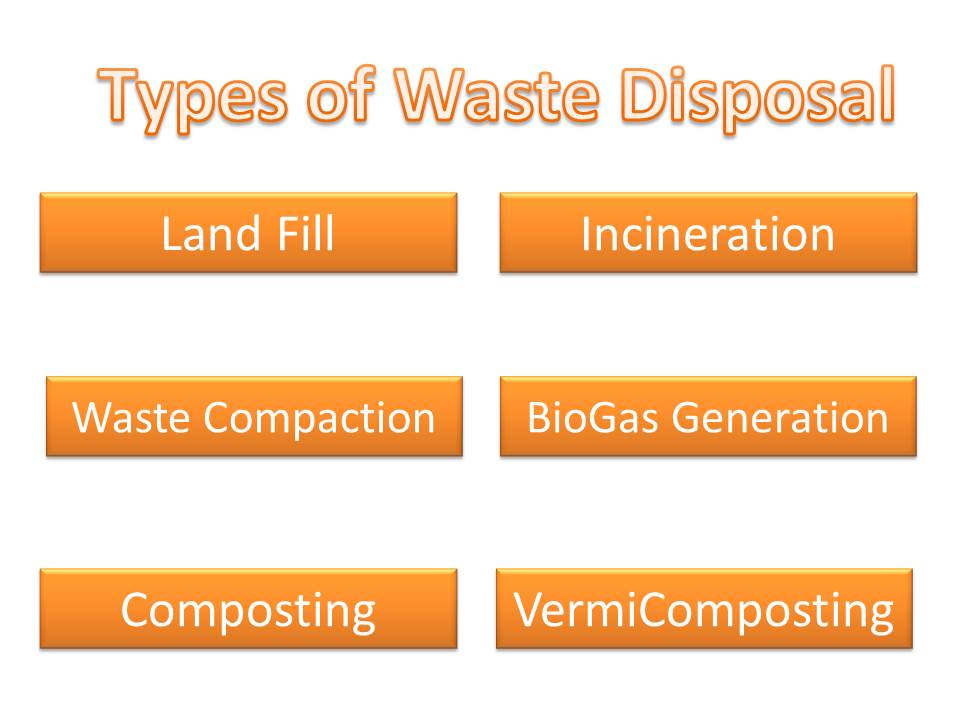
Waste management encompasses a series of activities and measures aimed at handling waste from its creation to its ultimate disposal.
It ensures adherence to environmental best practices through rigorous monitoring and regulation.
The steps involved in waste management are as follows:
1. Waste Segregation
2. Collection
3. Transportation
4. Treatment
5. Processing & Recycling
6. Disposal
Biodegradable Waste
Waste originates from plants or animals and can naturally decompose in the soil due to various natural agents such as weather, water, air, heat, microorganisms, and more.
Biodegradation
The process of decomposing garbage or waste materials through the activities of living organisms or biological processes.
Read More
- Class 10 Notes for Science NCERT
- Chemical Reaction and Equation Notes Class 10 NCERT Sci. Ch.1
- Acids Bases and Salts Class 10 Notes of NCERT Science Ch. 2
- Life Process Notes Class 10 NCERT Science Chapter 5
- Control and Coordination Notes Class 10: NCERT Science Ch. 6
- Class 10th How Do Organisms Reproduce Notes: Science Ch. 7
- Class 10th Heredity and Evolution Notes: NCERT Science Ch. 8
- Human Eye and the Colourful World Notes Chapter 10 Science
- Class 10th Chapter 11 Science Notes for NCERT Students
- Notes on Magnetic Effect of Electric Current Class 10 NCERT
- Metals and Non Metals Class 10 NCERT Science Chapter 3 Notes
Frequently Asked Questions on Notes of Our Environment Class 10
Q 1: What are the four types of environment?
The four types of environment are the natural environment (consisting of all living and non-living elements in nature), the built environment (human-made structures and infrastructures), the social environment (interactions and relationships between individuals and groups), and the cultural environment (beliefs, values, customs, and traditions).
Q 2: How can we reduce biomagnification?
Biomagnification can be reduced by controlling the use and release of harmful substances into the environment, particularly those that are persistent and non-biodegradable. Implementing proper waste management, recycling, and using eco-friendly products can help minimize the accumulation of pollutants in the food chain, thereby reducing the potential for biomagnification.
Q 3: What is biological magnification Class 10 notes?
In Class 10 notes, biological magnification, also known as biomagnification, is described as a process in which certain harmful substances like pesticides or heavy metals become increasingly concentrated in living organisms as they move up the food chain. The notes emphasize the importance of understanding this phenomenon and its consequences on the environment and human health, highlighting the need for pollution control measures.
Q 4: What are the main points of our environment Class 10?
The main points covered in Class 10 regarding our environment include the significance of preserving natural resources, understanding ecological balance, identifying various types of pollution. The concept of biodiversity, and the need for sustainable practices. Students also learn about the impact of human activities on the environment. Also, how individual actions can contribute to conservation efforts for a healthier planet.